#the objective hierarchy of the multiple states of being
Explore tagged Tumblr posts
Text

“the idea of "sphere" or of "realm" is frequently found in the texts in connection with the jhāna; that is to say, the jhāna introduce us to one of the "spheres" that are included in the objective hierarchy of the multiple states of being. There is even mention of "heavens": with the jhāna one is supposed to reach the "heavens of pure forms" or at least to prepare a way that leads to them. There is also mention of spirits or gods or angels of one or other jhāna sphere, and contacts that ascetics have had with them are discussed. Details are actually given. The bodhisattva, that is to say those who are advancing toward full illumination, are supposed, to begin with, to perceive a bright formless splendor; by purifying the "eye of knowledge" form also is perceived; at a later stage actual contacts ("to converse together") may even take place and, furthermore, they may come to recognize the hierarchical place of these beings ("to which celestial world they belong").”
― Julius Evola, The Doctrine of Awakening: The Attainment of Self-Mastery According to the Earliest Buddhist Texts
#The Doctrine of Awakening#Bodhisattva#Buddhist Philosophy#The Celestial Worlds#the objective hierarchy of the multiple states of being
1 note
·
View note
Text
My theory on Nikitas death:
Russian Prisons are well-known for their violent ways of treating the prisoners. There a plenty of russian organizations that document about what is going on in those prisons and its beyond the extremes.
Inmates are routinely getting r*aped with different objects, beaten up to the point where their face is unrecognizable anymore, for not fulfilling their tasks correctly, getting their food and water takien away, etc. This topic is being talked about often in the media, but it is often being surpressed by the russian government. It would be worth a google search as there are plenty of articles about their prisons.
Multiple news reports say different things about his death. Some report that he slashed his wrists on the 30th of november and was found dead in the early morning of 1st December. Other sources report that he was found with slashed wrists on the 28th of November and brought to a hospital, but died on the 30th of November. That means they had 2 entire days to save him from bleeding out. This just doesnt sit right with me..
Nikitas former cellmates reported that he would go as far as attacking other inmates just to see artyom once again, and that his plan was to „intimidate“ the officers by staging a suicide attempt so he, once again, could see Artyom. Artyom also told his lawyer that Nikita would kill himself or die in some other way at that prison without him. At the time of his death, year 2021, he had already served 10 years of his sentence, so he was already halfway there to getting released. His mother once stated that she would be waiting for him so she could talk to Nikita and let him explain everything. It could be very well possible that he didnt mean to kill himself, and the guards who saw him just let him bleed out instead of getting help for him. Thats how russian prisons are…
An intentional suicide could have also been a reason he has died. I mean he had been diagnosed with an mental illness before he was imprisoned, and might have been suffering from schizophrenia or a schizotypical personality disorder, he was very depressed, was being bullied his entire life (even in prison), had a very low position in the prison hierarchy, never had a real friend (he considered artyom one), and that of course could have contributed to what he had done. Its hard to say whether his death was a intentional suicide, an accident, or if he died because of how he was treated there.
But i guess well never know the true answer.
R.I.P Nikita.🕊️

im sobbing just look at him :(
(If you or someone else that you know is a subject to bullying, help them, let someone know about that, or reach out someone you trust before its too late. Being bullied is something serious and you should never let anyone, including yourself, go through that. There are people who care for you •3•)
#teeceecee#nikita lytkin#true cringe community#nikita and artyom#tcc columbine#tcc artyom#eric columbine#artyom anoufriev#pekka eric auvinen#tcc art#irkutsk molotochniki#артём ануфриев#никита лыткин#иркутские молоточники
168 notes
·
View notes
Note
https://www.tumblr.com/redfacedpalindrome/780761649625890816/genuinely-think-some-ln4-fans-watch-races-with
re your post, genuinely asking, not trying to start an argument or anything … so you would rather lando just not state his truth and keep his mouth shut so as not to hurt the feelings of other drivers whose teams are not able to properly provide for them? genuinely want to know your take as to why you think it’s lando’s duty to sugarcoat the difficulty he’s having with his car. he’s stated multiple times (including more than once in the drivers press con post this race) that the car is great, the team is great, it’s he himself who’s not able to gel with the car right, so it’s his fault and he needs to figure it out and fix it. in all of this, what exactly is the problem? why should he be expected to pretend that everything is okay when it’s not?
once again stating that i don’t mean this to be confrontational at all I just need to understand the reasoning behind your take and takes similar to yours
no you're right! and pls, absolutely would love to have a conversation about this always and thank you for asking kindly!
i often have posts with a lot of different sentiments (ex: me defending lando yesterday) but i think it's also cos it takes me time to mull over a complicated situation and new information is made available to me and i often just form new opinions. and i'm never going to stop doing that because i would hate to lock myself into my first (often wrong) opinion. but in this case i think i offered a fairly measured (albeit not completely objective) reaction.
for the record i tried to make it as clear as possible that i don't think lando has done anything wrong on like a grander sense. in fact, him and the team have done EVERYTHING right and that is a good thing. i know lando has recently gone out of his way to acknowledge the car has pace (and osc is finding it) and that the team has his back. he shouldn't be expected to pretend everything is okay when it's not, and to be fair he's had his own mechanical issues with the brakes in china and stuff.
i didn't wanna tag that post as anti-lando because i really swear i'm not. i want him to find his first wdc this year - i'll always want it for charles first but genuinely i'd be really excited if lando wins. and lando, like every reflective and effective driver, does a good job of introspecting on what isn't working and he feels like the car isn't working for him and that's fine.
but my god did bahrain show that even if it's not working for him it's miles ahead of the pack. and thus, i'm frustrated by circumstance. and my frustration with circumstance is what drives me to a bit of frustration with the sentiment he expresses. i'm not going to pretend like this is an objective take - it's really not. it is fueled by a lot of bitterness with ferrari because while i'm a mclaren fan i'm a charles fan first and i wish i could mix around the hierarchy cos damn i'd be happier :(
tldr- lando is allowed to say absolutely whatever he wants – especially when he, more than me, is being objectively right. i think it's good for him to be reflective and acknowledge areas of weakness. he definitely shouldn't change up his pr strat because i, redfacedpalindrome on tumblr, was annoyed about it. a more objective take wouldn't have pointed it out but guess what: i want champagne problems for charles. i badly want champagne problems for charles and instead he is WORKING IN A COAL MINE.
#pls understand this snl reference otherwise i've ended this sounding like a crazy person#you ask i write an essay#sorry maybe i should have tagged it anti-lando norris given that i acknowledged that i was being a little biased#but i really thought i broadly gave him credit#formula one#charles leclerc#cl16#lando norris#ln4
14 notes
·
View notes
Text


“The secret is to really begin”
The point of departure for what follows is simple: revolution is not around the corner. Presumably most would agree, yet the road forks sharply regarding how best to move forward. The Left maintains that proceeding into open conflict with the state and capital would be premature, given that “the masses” can’t be expected to join any time soon. A reformist agenda is sought instead as the only realistic approach – just until the conditions necessary for revolution arise. But there’s a big problem here, because to merely wait for the revolution ensures it will never arrive. Contrary to Marxian dogma, there’s nothing about revolution that’s inevitable; rather, the only thing that invites the right historical conditions – the only thing that can actually bring revolution any closer – is to proceed to action now, even if the time is not ripe. When undertaking a momentous project of any kind, it’s always necessary to start by taking a few decided steps, even if at first they lead into the fateful unknown. Those who merely wait, too unsure of whether to get going at all, guarantee their destination never comes any closer. Only by testing the boundaries of the existent do you begin to learn just what is and isn’t possible.
In this formula we find our foothold: the nucleus of revolutionary possibility resides in our determination to live free already now. The liberal idea of freedom is that of a ghost, one of meaningless hypotheticals, of incarcerated desires: you can think and do absolutely anything you want, but only insofar as it makes no difference in material terms. Of course, there’s a great deal to power that’s abstract and intangible, open to critique but not physical assault. Yet this is only part of the picture, given that you can only change so much on a subjective level – really not much at all – before your growth becomes limited and deformed by the bars of this cage-society. Enclosed by the system of death, the only way to make sense of our lives – the only way to be sure we’re still breathing – is by striking back against the physical infrastructure that holds social hierarchy in place. Beneath a veneer of calm supremacy, only a little investigation reveals that, through being spread so thinly, such objects are actually quite vulnerable. Even more so in an age in which everything depends on the most fragile of technological flows. Computer algorithms, fibre optic cables, and electrical transmitters hold the system together far more effectively than the words of politicians nowadays. Power is everywhere, yet the repressive forces are not, nor could they ever hope to be.
A single act of sabotage is, of course, of no great concern for the stability of the system overall. But there’s something extra here, something that spans the vast divide between individualistic revolt and insurrection itself, and that’s the capacity for insurgency to spread throughout the population. By acting now, the very quality of revolution – of uncompromising, autonomous revolt – begins to infuse the social terrain. Then it’s only a question of multiplication over creation, something altogether more approachable. There will always come unpredictable moments of future turmoil, moments in which the animosity of state and capital has been violently exposed, the futility of legalistic engagement revealed for all to see. Those who previously disagreed with confrontational tactics might well find themselves grasping for the right means of expression. And at that point the clashes have the potential to spread like wildfire.
This potential can be nurtured by a particular consideration, namely, the reproducibility of our own techniques. By focusing on tactics that require little or no specialisation, meaningful revolt is able to avalanche much quicker during moments of heightened social tension, greatly surpassing application only by a handful of experienced militants. This emphasis is exactly what was missing from many of the armed struggle groups active in Europe during the 1970s and ‘80s, such as the Red Army Fraction in West Germany and the Red Brigades in Italy. These professional revolutionaries required extensive training, specialised weaponry, and vast support networks in order to offer their contribution, promoting an idea of struggle (or at least of its highest forms) as something highly exclusive. Such isolation is forever the swamp of revolutionary potential, distinguishing the insurgents all too clearly from the rest of the population, drawing combatants into a pitched battle between two armies. On the contrary, the extent to which methods of struggle are easily reproducible – focusing on widely accessible tools and information – is the extent to which citizens can, even in a heartbeat, transform themselves into insurgents. Not only that, it also means those just getting involved can already struggle with as much intensity as anyone else, in no way relegated to the indignity of a secondary role. Forget about the vanguard, it has no use to us: generalised revolt, lacking leaders or a focal point, is exactly what no army or police force could ever hope to contain.
The moment of rupture is always much closer than it seems. The substratum underpinning all the everyday monotony is one of wild rebellion, and spontaneous community, which the present order must work day and night to subdue – often unsuccessfully. No longer can we profess to know in advance whether our intervention will not lead to a future insurrectional situation. The social conditions that gave rise to economic determinism have fallen apart: the metamorphosis of the economy has ransacked the factories, creating generations of non-citizens with no solid identity to bind them to this rotten world. Particularly in the ghettoes of the modern metropolis – in Paris 2006, London 2011, and Baltimore 2015 – the unpredictable nature of the historical moment has already been revealed, each case offering a clear image from the future. It’s as if the air is steadily getting drier, the slightest spark ready to set off a blaze. Especially once the environmental crisis can no longer be ignored, that dryness will become much more literal, calling into doubt the once undisputed stability of many regimes. Surely the only option is to make the most of the inevitable volatility, transforming these blind moments of rage into conscious insurrections – even revolutions. Any social order founded so strongly on hierarchy forever contains the seeds of its own collapse. Insurrection is merely the sudden bang let off as a structure, which had already long been falling, finally crashes to the ground.
Imagine a collective gasp for oxygen in a life defined by suffocation. A million gestures of indignity, previously suffered in silence, abruptly come to the surface. The illusion of social control – held together by fear, not respect – has been decisively cast off, all sections of society invited to project their newfound freedom into the void. Insurrection doesn’t divert the course of the dominant order, it derails it. Work grinds to a halt, students refuse to study, the economy is thoroughly paralysed; goods are circulated without money, public spaces transformed into theatres of discussion and festivity, the laboratories of exploitation overrun in broad daylight. Free play streams through the streets, manifest in a million different ways. Such is the spirit of insurrection. It is social, not military – the moment in which dissonance resonates.
The point of insurrection is to begin the revolutionary process in its full intensity, bypassing any notions of a transitional period. Such an event is clearly far more profound than any riot; nonetheless, it’s also defined by the fact it stops short of bringing about an actual revolution, failing to hold down either the necessary time or space. The quantitative limits of the uprising, however, are no excuse to label it a failure: such an intense encounter is its own reward, wholly worthwhile even when taken in isolation. Not only that, insurrections nurture the potential for more ambitious experimentation, for ruptures that last. Even once the fires have gone out, what remains are forged affinities, honed skills, deepened perspectives. And the population at large has gotten a taste for freedom no queue at the polling booth can soon quell. This is a concrete idea of what it looks like to do serious damage to Leviathan, even if it isn’t yet a deathblow. Along the insurrectional path, we forge beyond the revolutionary impasse.
Of course, there’s a strong sense in which this topic – equal parts festivity and devastation – shouldn’t be dressed up in too much poetry. Especially when true freedom is a novelty, there are many risks involved, risks that shouldn’t be trivialised. But what also cannot be denied is that every path, including inaction, necessarily comes with its own hazards. There are no easy options here. No promises to escape the gravity of the situation. As if allowing things to continue like this would be the non-violent option? Such is the right of the dominant culture, to present itself as neutral, ambient, even as it ravages the fabric of life to its very core.
It’s not as if we chose to be born into such miserable conditions. Yet how we respond remains entirely down to us, an infinity of potential choices vibrating through every moment. The opportunity to live passionately lies open to us still – no authoritarian regime could ever take that away. As Bonanno once put it, “It is not a question of opposing horror with horror, tragedy with tragedy, death with death. It is a confrontation between joy and horror, joy and tragedy, joy and death.”
#anti-civ#anti-speciesism#autonomous zones#climate crisis#deep ecology#insurrectionary#social ecology#strategy#anarchism#climate change#resistance#autonomy#revolution#ecology#community building#practical anarchism#anarchist society#practical#practical anarchy#anarchy#daily posts#communism#anti capitalist#anti capitalism#late stage capitalism#organization#grassroots#grass roots#anarchists#libraries
4 notes
·
View notes
Text

Part 1. Don't be One or multiple, be multiplicities!
Reading Deleuze and Guattari makes you wonder why is it that there has been so much difficulty in embracing multiplicity. Why the need, over and over again, to reduce the incredible abundance and diversity of life to a permanent first principle, an arkhé, an origin, a fundamental One from which all would derive? Philosophers gave it different names: first cause, form, god, subject, structure, universal, totality, state, etc., but it’s always the same hierarchical way of thinking, the same reduction. Why the need? Why can’t we be just fine with multiplicity: an endless, irreducible, immanent proliferation of difference…? Is it out of fear? Is it because multiplicities are more difficult to grasp and control? Because they change? Does the unity that remains forever identical to itself bring some of us more tranquility and peace of mind, though deep down perhaps we know it’s a fiction? Or is it because we have always lived in hierarchical societies and thus haven’t been able to think beyond social and political organizations that place a powerful head on top?
Either way, Deleuze and Guattari are not so much interested in answering these questions. Their problem is not so much why, but how different modes of thinking operate and what consequences does each have in the ways we live and relate to one another. Let’s explore them.
Logic of the One and the multiple: trees and roots
In A Thousands Plateaus, they will use the image of the tree and the root to characterize a way of thinking that in their view has dominated Western reality and thought for centuries. The root-tree logic acknowledges that there are multiple things in the world, but then invariably reduces all this abundance to a previous One from which it would derive, just as branches break off and grow from a central trunk. The problem with this logic, they argue, is that it cannot understand multiplicity. It can only think the multiple in terms of the One, but never on its own right or without reference to a presupposed unity somewhere.
The capital letter in the One highlights the fact that, according to this logic, the One is the foundation of the multiple and ontologically superior. This means that only the One is truly and properly real. And it can be so because is one, permanent and identical to itself, a transcendent plane that is above or beyond the degraded plane in which the multiplicity of disparate beings are born and die. This is what metaphysics as a tradition of transcendence has been thinking for so long throughout the history of philosophy, and what Deleuze and Guattari will try to contest: there is a transcendent One that explains everything that exists.
An obvious example of this logic is the belief in a transcendent God as the creator of the diversity of creatures in the world, or Plato’s theory of Forms, but there are many less obvious ways in which this mode of thinking has permeated (and still permeates) thought and life. As Nietzsche once said, we might have killed God but we haven’t killed its shadows. The One has many masks.
We know we are under the spell of this logic whenever we cannot think of a people without a guiding leader, a group without boss, a body without organism, an organization without center, transmission without filiation, difference without hierarchy. We live by this logic when we long for roots and a firm ground, when we see the world in terms of subjects and objects, each thing a separated unity standing on itself, each of us a separate autonomous individual, the one and only source of our innumerable actions, feelings, and thoughts. Subject and object are just modern avatars of the One.

Deleuze and Guattari carefully examine how the root-tree logic has been predominant in botany, biology, theology, philosophy, education, linguistics and psychoanalysis. To take the latter as example, Freud had just discovered the wild multiplicity of the unconscious, but then he had to bring back the unity and the One in the form of some fundamental complexes and central figures (the Father). He had just encountered sexuality as a polymorphous multiplicity of erogenous zones and sexual drives in the body, when he redirected all that diversity to a genital organization led by a central organ (the Phallus). Maybe he couldn’t do otherwise, since the tree had been planted for so long in our bodies and sensibilities, in kinship as well as in political organizations (of course the State is a tree, political parties are also trees).

So if we are tired of this arborescent logic that has brought so much suffering, as Deleuze and Guattari claim it has, how can we feel and live and relate to one another in a different way?
Logic of multiplicities: rhizomes
Fortunately, there are always other ways of thinking. Deleuze and Guattari argue that we are on a better track to understand the multiple when we no longer treat it as an attribute of things but as a substantive, a reality on its own right: multiplicity. The concept of multiplicity will help us to get out of the logic of the One and the multiple.
As in any way of thinking, procedures can be followed here, because multiplicities must be constructed. Our common sense tells us that we build multiplicities by adding new and more dimensions. Although this is a possibility, they propose to follow instead the simple operation of subtracting the One. If n is an open quantity and 1 is the One, this is how the method for constructing multiplicities could be expressed:
N – 1
A multiplicity is thus a multiple without a transcendent One. And a system like this is a rhizome.
Now anyone can give it a try and subtract the unity from any matter they consider. It’s incredible how all things are transfigured when the One is subtracted from them. The “thing” that seemed to be a substance closed on itself and separated from the rest suddenly dissolves into a multiplicity of relationships, materials and speeds when we change the perspective. And at the same time it reveals its intimate connection with thousands of other things to which it is assembled and without which it could not exist.
When Deleuze and Guattari encourage us to construct multiplicities, this means literally making them ourselves, but it could also mean learning to see them, because they are already everywhere. It is a matter of perceptual semiotics (learning to perceive differently), as much as a question of pragmatics and construction. In both cases the operation we follow is the same: the subtraction of the One.
If we are able to go through the first vertigo of living in a reality without foundation, without a solid ground under our feet, everything could become much more alive and full of possibilities. N – 1 means removing the foundation from life (or what Nietzsche had thought of as the death of God). It is also abandoning the idea that there is a single correct interpretation of existence, a truth. Subtracting the One opens up the field for a multiplicity of perspectives!
Let’s now have a look at some characteristics of the rhizomes.
Connection and heterogeneity
In a rhizome any point can be connected to any other and must be. This contrasts with roots and trees, in which some points are not connected to one another and maintain only one-to-one relationships with a center within a fixed order. The rhizome encourages us to make new connections in all directions: horizontal, diagonal, transversal, and above all to experiment. It is a creative procedure, since the new always arises from the production of new relationships.

The rhizome is a conjunctive logic of “and… and… and…” that connects the most heterogeneous. It produces aberrant connections between traits that we did not believe could ever be related, monstrous marriages between different kingdoms: the mineral kingdom mixed with the human, plants mixed with animals. Rhizomes grow out stems that break with disciplinary boundaries and their desire to preserve clear-cut limits, mixing the political, the biological, the semiotic, the human, the non-human, machines, territories, art disciplines, etc.
One of the examples that Deleuze and Guattari explore is the horizontal transmission of genes between different species without a common close ancestor. If genetic transmission tended to be thought of in vertical and arborescent terms, from parents to their offspring, there are recent studies in fish that show that a certain gene responsible for an antifreeze protein could be transferred horizontally through viruses between herrings and silversides, two species that have nothing in common.
In lingustics, Deleuze and Guattari question the attempt to study language and grammar in isolation. Language is not separated from political and economic dimensions. Furthermore, the search for a universal linguistic structure behind all particular languages is the same old search for roots and for the transcendent One. They will claim, on the contrary, that all there is is the multiplicity of dialects, slangs, specialized languages, patois, etc. There is no One hidden behind, multiplicities are all we have…
Multiplicity and asignifying rupture
As we already saw, rhizomes are multiplicities in which the One only exists subtracted. Therefore they have no object or subject, since these are versions of the One. A multiplicity is not a One that becomes two, and two that become four, etc. It is not a One that directly becomes three and four, nor is it a One that will arrive in the future. There is no pivot, ground, center, leader, origin, trunk, base, model, foundation or head to be found anywhere. Rhizomes have no beginning or end. They are just horizontal connections growing and flowing in all directions, always from the middle. Having no head or center, rhizomes can break or shatter at any point and they will begin to grow again from other lines. (Anyone who has tried to get rid of ants knows this: ant colonies are rhizomes.)
In fact, a rhizome is not made of points or elements but of relations, lines and dimensions. When a multiplicity establishes new connections, the number of dimensions increases and the multiplicity changes its nature, it undergoes a metamorphosis. A new connection and relationship brings about a change in nature. This change occurs through what Deleuze and Guattari call the line of flight. Every rhizome has lines of segmentarity (which give it some sort of organization, meaning, territory) as well as lines of flight, through which ruptures occur and the rhizome can become something else, escape from its previous organization (see last section).
Mapping and decalcomania
The logic of the tree is a logic of identity and being, of predetermined and fixed paths, of tracing and reproduction. The theoretical models that in some disciplines (for example, in developmental psychology) use concepts such as genetic axis and deep structure are forms of tracing and, therefore, modes of arborescent thinking. A genetic axis functions as a fundamental model along which stages occur one after another, always the same, a first model in relation to which any development, human or social, is thought of as monotonous copies.
But they reject any idea of a predetermined destiny, of movement along a succession of stages towards a predestined goal or end, whether for individual life or in the case of history (history is rhizomatic and without telos). The rhizomes are not tracings, they are maps. Maps allow you to experiment with the world, not its reproduction. They are connected with action and creation. They can be reworked, used and assembled in very different ways, and are susceptible to constant transformation as the experimentation moves along. Like burrows, they have multiple entrances and exits, lines through which it is possible to escape when necessary.
At this point, someone might ask: Isn't the difference between tree logic and rhizomatic logic a new kind of dualism?
To deal with this problem, Deleuze and Guattari create another concept closely related to that of the rhizome: the concept of assemblage. Any aspect of the world or process we consider is an assemblage of diverse relationships. A relational interweaving of lines, speeds, forces and heterogeneous materials in motion. Assemblages can acquire stability and consistency over time, they can solidify, allowing well-defined territories to emerge, so that we can recognize something as “a thing” and give it a name. But they never cease to be multiple and they never cease to be in motion, no matter how finished or fixed they seem.
In any assemblage, we can distinguish lines of segmentarity that cut and compartmentalize what flows, we can distinguish territories, strata and meanings, but at the same time all of this always coexists with lines of flight and movements of deterritorialization that escape those stratifications. This means that even the situation that seems most static, unitary, still, closed and unchangeable contains within itself an overflowing multiplicity that is always escaping and is always ready to establish a new connection and deterritorialize.
The difference is that for Deleuze and Guattari these strata, territories and meanings, these instances of stability, unification and organization, do not have a first or founding ontological status, since the One has already been removed, but rather they are effects that emerge and sprout from the multiplicity in becoming, as if they were crust that temporarily hardens from a magmatic chaos that never stops flowing.
Thus, the invitation of Deleuze and Guattari is already made:
Don't be One or multiple, be multiplicities!
Here you can find a pdf version of A Thousand Plateaus:
https://files.libcom.org/files/A%20Thousand%20Plateaus.pdf
6 notes
·
View notes
Text
headcanon. on Eternal Paradise faith.
In canon, the cult of Eternal Paradise takes inspiration from the real life religion of Karma Kagyu wherein a spiritual leader, known as Karmapa, acts as the figurehead & teacher. In composing my personal headcanon about how the cult operates in terms of religious worship, I have combined certain elements of different Tibetan Buddhism schools and sprinkled a dash of fantasy & personal interpretation of things. As such, this is a completely fictional religion that only takes inspiration from real life practices.
Disclaimer: I will be enhancing this post in the future as I see fit.
THE BASE COMPONENTS OF ETERNAL PARADISE FAITH
belief (ideas and values)
The core belief is that there exists a state of utmost peace & tranquility, that can be achieved only by severing all ties with the mundane world. Emotions are seen as a burden that weighs one down from achieving such a state and are thereupon 'entrusted' to the Lord Founder, who is considered capable of receiving them as he has already achieved such as a state and is able to mediate between this world & the next one. For that reason, the Lord Founder is the only one capable of guiding his principles to their ascension.
mythology (supernatural and sacred stories)
Much like real life Buddhism, Eternal Faith has no creator of the world and instead teaches that past events are the reason for present events that become the reason for future events. There are however, symbolic objects & deities, that would be called upon but not worshipped.
The lotus: The lotus is a symbol of purity & enlightement, thus its predominant appearance in works of art produced by the faithful. The Lord Founder himself would be depicted seated on an open lotus that symbolizes both his eternal nature & status as a being who appears in the mundane realm but simultaneously dwells in the spiritual one.
Muzan in Eternal Faith depictions plays a part similar to the Mahakala/Black Cloak; a personal protector of the Karmapa. Muzan would be depicted in paintings as a deity with multiple limbs & twelve blazing red eyes, usually wearing an expression of tranquility, a smile & having his predominant eye pair closed. He is often painted with long dark hair & wearing fabrics typical to the edo period, seated on a blue flower with long, slender petals. He has two forms; his male one being represented by the moon, symbolizing compassion & his female one being represented by the sun and symbolizing wisdom. As a protective deity, Muzan's female form can be wrathful towards those who are purposefully deviant as she is all-knowing of their intentions.
practices (rituals and rites of passage)
Guidance Council: private audiences with the Lord Founder, in which one would be guided to relief from concerns & burdens. Because of his innate innocence & compassion, the Lord Founder receives all troubles without judgement, and thus all should be entrusted to him, should one wish to be purified.
'Mindfulness' Practice: refers to a type of meditation/yoga that centers around abstinence from the five physical senses. It is considered a purification practice that ought to be repeated daily until one reaches a state where they are eligible for ascension.
Ascension Ceremony: The highest honor possible to achieve within the cult is to be recognized as worthy of entering "Eternal Paradise" — which is not only a state of great perfection but also a different realm of existence.
Room of Rememberance: Those who have come to pass within the temple without achieving their ascension would still be commemorated, in alignment with the principle of Compassion for others. Their physical remains are to be guarded eternally by the Lord Founder, who, alongside his principles, tends to their remains & protects them.
social organization (community).
At the top of the social hierarchy stands the Lord Founder, the enlightened one, who is believed to consciously be in a constant state of serenity & inner peace, thus acts as a beacon & paradigm of the ultimate state of being one can hope to achieve.
Status within the cult is granted by means of 1 ) longetivity & 2 ) the Lord Founder's favor. As such, the Lord Founder can judge which faithful are closer to achieving enlightement and thus grant them a higher social status. This process is usually unofficial and happens through daily interactions.
The newest recruits are considered to be most impure, as they have not dwelled within the temple long enough to shed the burdens & troubles of mundane life that corrupt one's spirit & make them vulnerable to temptation. Thus, those members receive special attention from others, seen as weak & in need of protection.
REFERENCES // SAMPLES:
Depictions of deities: ( 🇽 ) - ( 🇽 )
Chants: ( 🇽 ) - ( 🇽 ) - ( 🇽 )
2 notes
·
View notes
Text
The Nature of Initiatic Knowledge
Title: The Nature of Initiatic Knowledge
Tags: #Evola #InitiaticKnowledge #Tradition #Esotericism #SpiritualRealization
Knowledge as Being: Initiatic knowledge transcends modern intellectualism. To truly know is to be the object of knowledge, not merely to think about it. This requires a transformation of consciousness into the known reality.
Experimental Method: Initiatic knowledge is purely experiential. It is not based on abstract theories but on direct, individual experience. Certainty arises from lived reality, not intellectual speculation.
Beyond Phenomena: Ordinary knowledge is limited to the sensible world, which is finite and contingent. Initiatic knowledge goes beyond phenomena, seeking the absolute through direct identification with higher states of being.
Hierarchy of Experience: Initiatic teachings recognize multiple levels of experience, each corresponding to a different state of consciousness. These levels form a hierarchy, ascending from the sensible to the absolute.
Active Identification: True knowledge involves active identification with the object of knowledge, leading to a state of superrational clarity. This is distinct from mystical merging, which lacks intellectual precision.
Rejection of Profane Knowledge: Initiatic knowledge dismisses modern profane knowledge, which is abstract, democratic, and leveling. True knowledge is hierarchical and accessible only to those who undergo the necessary transformations.
Practical and Operative: The initiatic path is practical, focusing on the means to achieve spiritual transformation. It is not concerned with theoretical speculation but with the opus (work) of self-realization.
Differentiation: Initiatic knowledge is inherently differentiated. It cannot be universally transmitted without degradation. Each individual’s capacity for knowledge depends on their level of spiritual development.
Power and Justice: Authentic knowledge confers true power, rooted in spiritual superiority. This contrasts with modern technological power, which is mechanical, democratic, and devoid of spiritual value.
Superiority and Realization: The initiatic path leads to the transcendence of the human condition. True power and knowledge belong to those who have achieved this awakening, affirming their superiority through integration with higher realities.
The Nature of Initiatic Knowledge
Those who approach our disciplines must first understand this fundamental principle: the problem and meaning of knowledge are perceived in a manner entirely distinct from the frameworks of modern culture.
From an initiatic perspective, to know is not to "think," but to become the object of knowledge. True knowledge is achieved only when one’s consciousness is transformed into the known object. In this sense, knowledge is inseparable from experience, making the initiatic method purely experimental. Certainty here is rooted in direct, individual experience. In ordinary life, sensations, desires, emotions, or perceptions (such as pain, longing, or intuition) possess this experiential quality. Concepts of "true" and "false" are irrelevant; what matters is the absolute "Is" of the thing itself, experienced without the need for intellectual validation. This form of knowledge is absolute—there are no degrees, approximations, or probabilities. One either possesses it or does not.
For the ordinary individual, such knowledge is confined to the sensible realm, which is finite, contingent, and accidental. What is commonly regarded as knowledge is instead a system of abstract concepts, relations, and hypotheses, detached from direct experience. The immediate data of consciousness are often dismissed as mere "phenomena," with an assumed "true reality" posited behind them. For science, this reality is matter or etheric vibrations; for philosophers, it is the "noumenon" or "thing in itself"; for religion, it is a divine hypostasis. This creates a dichotomy: pure experience, due to its finite nature, is not considered "knowledge," while what is deemed "knowledge" lacks experiential depth.
The initiatic path transcends this dichotomy, emphasizing direct experience as the sole criterion. While ordinary individuals equate experience with the sensible realm, initiatic teachings assert the existence of multiple experiential levels, each corresponding to a distinct mode of perceiving reality. These levels are hierarchical, progressing toward greater absoluteness. There is no separation between a "world of phenomena" and an "absolute" behind it; the "phenomenal" reflects a specific experiential level and state of the Self, while the "absolute" corresponds to a higher state achievable through transformation. The measure of absoluteness is determined by the degree of active identification—the extent to which the Self is unified with its experience and the object is transparent in meaning. This hierarchy ascends from "sign" to "sign," culminating in a state of superrational, intellectual vision, where the object is fully realized in the Self and vice versa. This state embodies both power and absolute evidence, rendering rationalization and speculation obsolete.
Initiatic teachings view the mind's tendency to theorize and philosophize negatively. Such endeavors are futile. The real concern is practical: how to achieve the transformation and integration of experience. This is why Western initiation is associated with concepts like the "Art" (Ars Regia), the "Work" (opus magnum or opus magicum), or the symbolic construction of the "Temple." In China, the Absolute and the path converge in the term "Tao."
Modern spiritualism, with its speculative fantasies about cosmology and supersensible realms, fosters a flawed attitude. The initiatic approach values experiential practice, restraint, and silent action, guided by the Hermetic principle "post laborem scientia" (knowledge after work). Modern culture, far from being a prerequisite for spiritual realization, often obstructs it. A person untouched by modern intellectual and aesthetic contaminations, yet possessing an open mind, balance, and courage, is more suited to receive superior knowledge than any academic or "critical thinker." True initiates are reluctant to theorize; they simply point to the problem and the means, leaving the aspirant to act.
Initiatic knowledge also upholds the principle of differentiation, contrasting sharply with modern culture's egalitarian tendencies. Modern "knowledge" is democratized, accessible to all through education, but this applies only to abstract, conceptual truths. Initiatic knowledge, rooted in experiential transformation, is inherently exclusive. It corresponds to the hierarchical degrees of initiation and cannot be universally transmitted without degradation. Theoretical communication is useless; initiatic knowledge relies on allusion and symbol to provoke illumination. Without an inner movement, even these are valueless. Initiatic knowledge demands differentiation, recognizing that ordinary existence and sensible experience are incompatible with realization. This necessitates a rejection of modern criteria for truth and knowledge, reaffirming the principle of suum cuique (to each his own). Knowledge, truth, and freedom are proportional to one's being.
A common objection is that transcendent experiences amount to mysticism, offering no insight into external reality. However, initiatic "identification" is not a passive merging but an active, superrational clarity, distinct from mystical states. Furthermore, the notion of "explanation" in profane disciplines is illusory. Only initiatic knowledge, which identifies with the real causes of phenomena, can provide true explanation. This identification confers power over causes, a principle absent in modern science and technology. Modern technological power is democratic and amoral, devoid of true superiority. It is mechanical, lacking connection to the Self, and ultimately leaves humanity spiritually impoverished.
In the initiatic domain, authentic knowledge is justice, a natural emanation of an integrated life. It transcends abstract principles, grasping real beings through direct spiritual perception. Similarly, true power operates above natural laws, among the causes of phenomena, embodying the irresistibility of the superior being. This superiority arises from transcending the human condition and achieving initiatic awakening.
Metaphysical part:
On the Secret of Decay.
Those who reject the rationalist myth of "progress" and the view of history as an unbroken upward trajectory for humanity will inevitably gravitate toward the worldview shared by all great traditional cultures. At the heart of this worldview lies the recognition of a process of degeneration, a gradual darkening, or the collapse of a higher, earlier world. As one delves deeper into this ancient (yet renewed) perspective, several questions arise, chief among them being the mystery of degeneration.
This question is not new. When faced with the remnants of ancient cultures—whose names are lost to time but whose physical remains exude a transcendent greatness—few can avoid pondering the causes of their decline. The usual explanations often fall short.
The Comte de Gobineau provided the most comprehensive analysis of this issue, along with a critique of prevailing theories. His emphasis on racial thought and purity contains much truth, but it requires expansion to include higher principles. There are instances where cultures collapsed despite racial purity, as seen in certain isolated groups that faced extinction. For example, the Swedes and the Dutch remain racially unchanged from two centuries ago, yet their once-heroic spirit and racial consciousness have faded. Other cultures, like ancient Peru, persisted as hollow shells, easily toppled by external forces.
From a traditional perspective, the mystery of degeneration becomes even more complex. Cultures can be divided into two types: traditional and modern. Traditional cultures are rooted in metaphysical, supra-individual principles, forming a hierarchical order centered on the spiritual. Modern culture, in contrast, rejects tradition, focusing solely on human and earthly concerns, detached from the "higher world." From this standpoint, history is a story of universal decline, marked by the fall of traditional cultures and the rise of modern civilization.
Two key questions emerge:
How did this decline occur? The evolutionary notion that the higher emerges from the lower is flawed. Similarly, the involutionary idea that the higher can fall requires explanation. Analogies like health turning to sickness or virtue to vice offer some insight but fall short of a true explanation.
How does the degeneration of one culture spread to others? The collapse of the ancient Western world and the global dominance of modern culture cannot be explained solely by material or economic conquest. European expansion not only brought material subjugation but also implanted modern, rationalist, and individualistic thought. Traditional cultures, even where they appeared intact, often harbored internal weaknesses, making them vulnerable to external forces.
The traditional view of hierarchy is not based on tyranny but on spiritual authority. The higher does not dominate the lower; rather, the lower recognizes and is drawn to the higher. This recognition forms the basis of traditional order, fostering sacrifice, heroism, and loyalty. When individuals deny the Spirit and sever ties to higher principles, the hierarchy collapses. This internal decay leads to external revolution and decline.
The fall of traditional cultures stems from a metaphysical decision: the rejection of the Spirit and the embrace of individualism and materialism. This decision, rooted in the misuse of freedom, is the core of degeneration. It echoes the Christian notion of the Fall of Man and the Rebellion of the Angels, highlighting humanity's capacity to destroy spiritual values.
Legends of eternal rulers, like the sleeping Emperor beneath the Kyffhäuser mountain, hint at the possibility of restoration. These figures symbolize the enduring presence of spiritual authority, which can be rediscovered through inner awakening. The fallen masses may yet return to the unchanging peaks, guided by the "magnet" of the Spirit. This hints at the secret of reconstruction, a topic for another time.
In summary, the mystery of decay lies in the rejection of higher principles and the misuse of freedom, leading to the collapse of traditional order and the rise of modernity. The path to restoration lies in reawakening the Spirit within.

0 notes
Text
Making the Most of Your Billboard Advertising

Billboards are outdoor advertising tools brands use to promote their goods and services. Unlike signs or posters, they have long-range visibility, with nearly 90 percent of adults in the US noticing them. Despite their size, effective billboard marketing requires strategic approaches to maximize impact, such as clear campaign strategies.
A strong campaign starts with a clear strategy focused on objectives and the target audience. Most businesses aim to boost brand awareness. In busy towns or cities, billboards can grab the attention of pedestrians or motorists. Understanding the target audience's preferences and behaviors helps tailor design elements and placement for optimal resonance.
Location selection is often about numbers, and successful advertisers usually consider high-traffic routes or those close to critical infrastructure and landmarks. But even in these prime spots, ensuring ads reach the right people is crucial. Data like road traffic counts, census information, and government reports can help identify ideal billboard locations. The terrain also matters—billboards in elevated areas enhance visibility, while those obstructed by natural features may fail to reach the audience.
In crowded advertising landscapes, message delivery is paramount. Successful advertisers embrace creativity to stand out, crafting the message to spark imagination without overwhelming the audience. Even in doing so, simplicity is crucial since road users constantly move and have limited time for information absorption. For optimal engagement, the primary message should be seven words or less. Then, present contact information in a legible format.
Design is one of the attention-grabbing aspects of a billboard. When creating billboards, brands should step into the customer's shoes. What elements are visually arresting? What might make someone take a second look? Prioritizing images over words also maximizes impact, as high-quality, thought-provoking, and relevant visuals leave more lasting impressions than text alone.
Design elements like color, font, and hierarchy help combine images and text. Billboards with bold, high-contrast colors are more noticeable from afar. Font size and style determine readability, with larger, easy-to-read typography ensuring the message is easy to digest. However, font choices should also reflect the brand's identity to maintain brand recognition, consistency, uniqueness, and authenticity. Hierarchy or layout—achieved by varying font size and contrast—helps brands prioritize their message and guide the viewer's eye in a logical flow.
Billboard advertising can be costly, particularly in high-traffic zones. As such, brands are now opting for digital alternatives. Digital billboards offer more flexibility and save costs long-term as they eliminate frequent installation and printing expenses. Unlike static vinyl billboards, digital options allow advertisers to experiment with different designs and run multiple daily campaigns. In certain states and municipalities, if allowed, one can incorporate dynamic content like animations and slideshows, making them more engaging and effective at capturing attention.
Memorability in billboard design goes beyond fonts and colors; it is also about using text that triggers emotions such as humor, empathy, or desire. Some billboards even tell a brief story through imagery or motion graphics, giving audiences a glimpse of the excitement or thrill a product offers. This emotional engagement can inspire viewers to feel a strong urge to purchase the product.
When considering billboard advertising, being mindful of the campaign's impact on the surroundings is crucial. Responsible billboard design extends beyond mere aesthetics. Advertisers should prioritize cultural sensitivity and general audience appropriateness in their imagery and messaging, avoiding offensive or insensitive content. Public safety is also essential, and advertisers achieve this by ensuring billboards don't block road signs or overly distract road users. Moreover, ethical considerations demand transparency and honesty in advertising content.
0 notes
Text
"Queen Victoria ascended the throne of England in August 1837, just as tensions in Lower Canada were reaching a boiling point. There is no indication that the seventeen-year-old monarch gave much immediate thought to the political squabbles wracking her North American possessions, but her coronation provided Canadians with an occasion for further reflections on sovereign authority and state forms. 'Loyal' Montreal managed to mount a parade to celebrate the happy event, and at Sorel the little garrison fired off a salute. A tavern-keeper's wife remarked to onlookers at the latter, 'There you are, celebrations for the coronation of the queen; she had better watch out or she'll be decrowned.' It was the Te Deum ordered for the middle of August by the bishop of Montreal, the usual service on such occasions, that aroused the greatest controversy. At St Polycarpe, where the cure dared to say a few words in praise of the new monarch, local patriots managed to stop the ceremony. 'No sooner did the Te Deum commence, than the people quitted the church bodily, leaving the women and marguilliers (churchwardens) to keep his Reverence company. The deputy beadle was beginning to ring the bell when the people got out, but the parishioners stopped him, telling him that the bell belonged to them, and not the Queen of England, and that it should not be rung. Note the language used by the Vindicator to describe this incident: the counterposing of 'the people' and 'the women.' Half the population of the province might well have viewed these words as ominous signals, emanating as they did from the presses of a journal dedicated to the principle of popular sovereignty!
That this was no accidental slip is underlined by the sexual references in protests against the coronation Te Deum. In the parish of Contrecoeur a radical merchant led an exodus from the church shouting, 'It is painful to have to sing the Te Deum for the damn queen, damned whore with her legs in the air.' A Patriot orator addressing the people of Nicolet from the church porch was reported to have said, 'As for the king, he is nothing but a big zero to whom Canadians pay a pension … The proof that kings are nothing but zeros is that we are now governed by a young queen seventeen years of age.' Later, at the time of the battles of November and December, an American patriot sympathizer got into trouble at St Athanase by throwing 'ridicule on the person of the sovereign by saying the loyalists were governed by a little girl, that they were governed by petticoats.' Such language would certainly have shocked English radicals; they were well disposed towards the young queen who seemed to them a much more sympathetic figure than her notorious uncle, William IV. At the same time, it directs our attention to some important characteristics of the Patriot movement as regards both gender and concepts of legitimate political authority.
…
Granted that the patriots objected to the institution of monarchy and to the fact of British rule; but why did they have to make an issue - and in such a cruel and personal way - of Queen Victoria's sex? Well, certainly their sensitivity was not unique in the international republican community of the period. …. considerations of sexual difference were of central concern to political writers and revolutionaries of the late eighteenth-early nineteenth-century period. To the degree that they challenged existing hierarchies on egalitarian grounds and insisted that 'the people' ought to rule, philosophes, Jacobins, and American patriots had to grapple with the question of what 'the people' was. It certainly was not all human beings resident in a given territory: not everyone was to participate equally and in the same way in sovereign authority. Women in particular tended to be excluded from direct political participation in the republican city. Pronouncements may have been cryptic and susceptible to multiple interpretations, with much assumed and little expressed; the effect was none the less for sex to become increasingly the primary dividing line between rulers and ruled in the age of the great bourgeois revolutions. Partly this exclusion arose by default, as older conceptions of political privilege based on birth, sacerdotal status, and so on came under attack, but also it derived from a profoundly gendered republican concept of citizenship.
Women were not always 'respected' under the new order: witness the patriots' misogynous and obscene verbal assault on Queen Victoria. In this respect, too, Lower Canadian behaviour seems to reflect widespread attitudes of the period, attitudes particularly characteristic of republicanism. What one might call the 'vulgar Rousseauian' outlook venerated the virtuous woman who kept to the domestic sphere, and was profoundly suspicious of any woman who ventured into the political realm. Quite apart from the fact that women were not by nature equipped to cope with public affairs, their attempts to take part in politics posed a direct danger to the hallowed conjugal family, because public life was conceived of in republican discourse as entailing a literally public performance open to the gaze of the community. Whereas for men publicity was the guarantee of virtue, the opposite applied for women. Self-display was repugnant to good women because it signified sexual immorality, just as surely as female confinement to private pursuits indicated chastity.
…
All the abuse of poor Victoria [also] indicates that of course the queen and the monarchy were not 'a zero' in the French Canadian countryside. For all that the habitants took for granted a certain popular sovereignty within the local community, their concept of the state and the empire was highly personalized, focusing on the reigning king or queen. There is nothing peculiar in this attitude; it is common among peasants throughout the western world. Even among the 'educated classes' the notion that a stable political structure needed to be embodied in a royal personage still enjoyed widespread support in the first half of the nineteenth century. Royalist habits of thought may have been somewhat more strongly entrenched in French Canada than in some countries, because there had never been a republican interlude here as there had been in England, the Netherlands, colonial English America, and much of Italy; there was no alternative to monarchy in the Lower Canadian historical memory. On the other hand, the conquest may have made the monarchy seem less sacred by demonstrating its mutability. If so, the resulting uncertainties must have remained largely submerged until 1837. People still expressed themselves in royalist language, government property being 'crown property’, military duties called 'the king's service'; even disaffected militiamen refusing to hear the governor's proclamation shouted 'Vive le roi!'
Canadians of course lived far from any flesh and blood monarch, although governors under the French and British regimes did do their best to put on a display of viceregal pomp and ceremony in the colony. More generally, political authority in our period did manifest itself in personal terms that reinforced monarchical habits of thought, no doubt accentuated by the strong military presence in Canada. Moreover, the Church did its utmost to impress on the faithful their duty to the king, not only in Te Deum services for coronations and royal births, but also in sermons from the pulpit. Political leaders added their voices in support, including the Patriots, who until the eve of the Rebellion always protested their loyalty to the crown even as they denounced colonial Tories and wicked British ministers.
A basically royalist political vocabulary does not imply a docile acceptance of authority. People who have been taught to regard the distant king as a father-figure who has the best interests of his subjects at heart, often tend to conclude, when things go badly, that exploitive officials, merchants, or aristocrats are the monarch's enemies as well as their own. In this way royalism can become a revolutionary ideology (though one with built-in limitations inhibiting the development of popular democracy), as it was indeed in countless plebeian risings, such as the one that shook rural France in the summer of 1789 when thousands of peasants attacked seigneurial chateaux, acting, so they thought, 'on orders from the king.’ It should be noted that the peasant class is not the only one that tends to venerate the king while blaming his advisers. The American and French revolutions were already well under way before their bourgeois leaders began to attack George III, Louis XVI, and the institution of monarchy. (Tom Paine's Common Sense caused a sensation early in 1776 when it called for an independent American republic.) Yet the dynamic of the revolutions eventually broke the spell of royalty and led to the full development of a republican political discourse, one that had often been there all along in embryonic form. So it was in Lower Canada, where the crisis of the 1830s moved the bourgeois Patriots to an entirely republican outlook. Hence their determination to discredit the monarch as the personal symbol of government authority and metropolitan rule.
One can also see signs of this anti-monarchical sentiment at the level of the rural masses. During the November insurrection a Constitutionalist merchant asked Jerome Longpre, an habitant leader, by what right he presumed to issue orders. ‘It is by our own right,’ came the reply. 'We couldn't care less about the king or the queen or the clergy.’ At Lacolle 'Down with the king!' was the rallying cry of men (obviously not up to date on dynastic affairs!) drilling for the coming struggle. During the second rising in 1838 Francois Patenaude indicated, in a moment of panic, who he thought the enemy was; rushing into the house he called to his wife for weapons, crying, 'we must defend ourselves against the crown.' Needless to say, there is something very naive in all this; the kings and queens in question lived thousands of miles away and had only the remotest connection to the Lower Canadian conflagration. On the other hand, such remarks indicate a conception of the conflict that transcended purely local concerns and went to the heart of the question of sovereign power. However crude the formulations, such language suggests a hard-won victory over the intellectual limitations inherent in peasant life. It was nevertheless a partial victory, for ingrained habits of thought do not die overnight. One man was denounced to the authorities for having sung treasonous songs at a gathering of habitants. Neatly balancing themes of republicanism and constitutional monarchy, the singer began with 'Allons enfants de la patrie, le jour de gloire est arrive,' then moved on to a second song: 'If our august queen knew of the abuses, she would say to all good patriots, crush these ass-lickers' (author's translation). More significant was the tendency of a personal cult to grow up around Louis-Joseph Papineau, a cult that in some respects mirrored the royal mystique. We can see the mental association between monarch and revolutionary leader in the words of another church-door orator, the blacksmith Edouard Moreau dit Duplessis of St Jerome: 'He sang a revolutionary song and cried Hurrah for Pepere (i.e., Papineau) … and he spoke in the most uncouth terms against our sovereign the Queen.’ Did the patriots then aim to liberate Canada from Britain only to subject it to a new monarchical yoke? This is what historians anxious to portray the movement as wholly retrograde would have us believe. But the role of charismatic leadership in a revolutionary movement is not quite so simple. Listen to the words of a Nicolet shoemaker overheard just before the battles of November 1837: '
L.J. Papineau would come with his people and they would go down to Quebec and capture the city … He would be happy to see the crown on Mr Papineau's head and if he did not behave properly as king, the patriots would replace him … We should make ourselves independent like the American government.'
Clearly we are dealing here with a man who has not read his Tom Paine; nor has he managed to find any but a royalist vocabulary to give voice to his political views. But just look at the sort of reign the shoemaker envisions for Louis-Joseph I: king as long as the majority approves his conduct! This is admittedly unsophisticated political thinking of a sort that would be vulnerable to Bonapartist demagoguery, but its essential thrust is more republican and democratic than royalist. The spell of traditional authority, as represented by priest and bishop, governor and queen, was giving way. People of different classes and levels of education were considering new ways of constituting a state and governing a human community. Could Canadians rule themselves? Could government derive its legitimacy from the people rather than historic rights of conquest and religious sanction? Patriot leaders answered these questions in the positive, and they drove home the point explicitly in speeches and newspaper articles, while expressing the same message in symbolic forms as well, notably through the use of flags and banners. Long before he began to take the movement seriously as a military threat, the commander of British forces in Lower Canada fretted over the emblems of popular sovereignty sprouting up in the Richelieu valley. The tri-coloured flag has been displayed at two taverns between St Denis and St Charles,’ wrote Sir John Colborne in October 1837. 'Many of the taverns have discontinued their signs and substituted for them an Eagle.’
Flags were an important element in the repertoire of symbols, and they were a favourite device at protest meetings, processions, and later at insurgent camps. Several designs were employed. Most provocative to Tories were the three-coloured banners (the sources do not specify which three colours), with their frankly revolutionary associations. Flags of American inspiration, featuring stars and eagles, were also displayed. Finally, there was at least one wholly original design, conceived apparently by Jean-Joseph Girouard of St Benoit. Girouard's flag, pierced with musket balls at the Battle of St Eustache, still survives. Its rather crowded features include maple leaves, pine cones, a Maskinonge fish, as well as the initials 'C (for Canada) and 'J-Bte' (for Jean-Baptiste). One might add to the list the various slogan-emblazoned banners flown from may/liberty poles and paraded through country parishes. There was, for example, the one carried to an anti-coercion meeting by a rural militia captain with 'a crown reversed and above it an Eggle [sic]' or the blazing red flag proclaiming the word 'Liberte' that went before a group of reinforcements headed for the Battle of St Charles. All these different pieces of coloured fabric held aloft on a pole had the effect of expressing and reinforcing a collective spirit. They also asserted, to one degree or another, the ideal of national independence. It is true that, while patriots were determined to rally round the flag, they were not at all sure which flag to gather under. This absence of a single national flag is perhaps a symptom of the movement's immaturity (hardly remarkable: the Americans had no common flag at a comparable stage of their revolution), as well as its vitality. Perhaps the most important feature of all the patriot banners is that none of them was the Union Jack and the message of that negation could not have been clearer.”
- Allan Greer, The Patriots and the People: The Rebellion of 1837 in Rural Lower Canada. Toronto: University of Toronto Press, 1993. p. 190-200.
#lower canada#lower canada rebellion#nineteenth century canada#canadian history#histoire de quebec#british monarchy#british empire#republicanism#patriotes#monarchism#rural quebec#habitants#academic quote
1 note
·
View note
Text
Analytical Application #5

Laura Mulvey, within her workings, introduced the concept of “scopophilia.” She states that this term is linked to the pleasure that comes from being the observer and the object of observations. According to Mulvey, the concept of the “male gaze” is directly intertwined with “scopophilia” (1). The cinematic structures reinforce the ideas of voyeurism targeted towards women.
We can see the workings of Freud being exemplified in the comic strips created by Neil Gaiman in The Sandman: A Game of You in multiple scenes. Starting with George, the creepy old neighbor, who is seen preying on all these young women. The theory of scopophilia is demonstrated when George grabs a scalpel to reveal a flock of crows bursting out his chest. In the first panel on the page, the poster of Barbie, the protagonist, is shown. This is a reminder of the objectification Barbie was subjected to under the male gaze of George. On that same page, George is seen looking out towards the city observing the sleeping women under the city skyline. In the comic the city is reflecting off the up close shot of George’s glasses, exhibiting a “controlling and curious gaze” (2). He is a reflection of the male gaze that lends itself to scopophilia. The crows being released are also a tool used for the observing of these women, the dreams are an extension of the mind and a further inspection of looking at each individual. George is receiving manifestations of love from the voices, gaining pleasure from looking as a person. On that note, as we know the concept of scopophilia refers to the relationship between the act of looking and being looked at. George, who was once the observer, became the object of the observation for all the women in the apartment complex. He became a picture on the wall, his only job was to be examined and surveyed by the women–becoming the exhibitionist.

Judith Butler's work on the deconstruction of the sex/gender binary challenges the notions of the traditional gender norms that have been institutionalized through the patriarchal hierarchy. The sex/gender binary states that sex and gender are synonymous–reinforcing the idea that your biological makeup is what defines gender. However, Butler challenges these ideas by stating that gender is socially constructed. Gender is not something that is inherent when an individual is born, but rather something someone “does” through their actions and mannerisms (3).
As Butler claims, gender and sex are not synonymous! As discussed, gender is a social construct that is perpetuated by normative heterosexuality. Sex/gender binary is not real nor accurate by any means, and this can be seen through the character Wanda in Neil Gaiman’s The Sandman: A Game of You. Wanda is a transwoman and throughout the storyline, her identity is brought up to keep the flow of the plot. In relation to Butler’s claims, Wanda disrupts the binary as a trans individual. She is a woman despite not fitting the alignment of the sex/gender binary. This supports Butler’s ideas, that gender is fluid and on a spectrum–gender cannot be limited to just the binary. At the same time, I think it is important to note that Butler sex and gender is not defined by the degree in which an individual is categorized through masculinity and femininity. Wanda’s character challenges the notion that gender is strictly determined by biological makeup–despite not undergoing bottom surgery, a gender-affirming surgical procedure for trans individuals to reconstruct their genitals to match their gender identity. Wanda’s character highlights the complexities of gender identity, and despite characters like George and the “I don’t like dogs” lady who question the gender identity of Wanda, she continues to stay affirmative in her gender expression. As Wanda states on page 413, “I was born a guy, and now I’m a gal.” Through Wanda’s character, Gaiman directly supports the themes within Butler’s writing–that gender is not just the binary, challenging his audience from the 80s and 90s on their understanding of sex and gender.

Through the workings of Judith Butler, gender norms are reinforced roles, traits, and behaviors onto individuals based on their societal perceptions on gender identity, how one is perceived based on their appearance. For example, some masculine norms can be connoted to strength versus feminine norms such as submissiveness. Butler’s theory of gender performativity emphasizes how gender is internalized and reproduced through the process of intake–gender is once again, a social construct! (4)
In Neil Gaiman’s The Sandman: A Game of You, it can be argued that the protagonist, Barbie, fulfills the role of the stereotypical “damsel in distress.” As stated above, gender norms are socially constructed that reinforce roles and traits for individuals based on their perceived gender. Due to Barbie being the conventional image of a woman in need of help, she fits the standardized definition of the “damsel in distress.” This narrative trope portrays women as helpless and vulnerable, lending itself to the reinforcement of traditional gender roles. A damsel is usually depicted as passive–unable to solve her own problems. However, I plan to argue how Barbie seems to fit the categorization of this trope, but breaks free from the constrictions of gender norms during the storyline. Despite needing the help from her neighbors, Barbie holds the agency to solve the issue and defeat the Cuckoo. Damsels are also described as submissive, however we see Barbie make her own decision when given a boon, not submitting to Thessaly’s demands. In many different scenarios, the damsel is objectified by the perspective of the audience and the male characters within the plot. Despite being objectified by different men in the chapter, Barbie breaks free from the objectification of men through her expressiveness in makeup and expression. Her oddball choices in painting her face disrupts the psychological desires of women to dress and present themselves as the standardized image curated through the male gaze. The damsel in distress trope serves to enforce patriarchal ideals of gender, however Barbie disrupts these ideas through her badassery!

The term “butch” can be defined as a way to describe lesbian women that express themselves with more masculine traits, characteristics, and mannerisms. This has developed into a stereotype and now an identifier within the lesbian and queer community. Although, in a slightly similar manner to positive images, butch lesbianism offers up visibility for the queer community, but it can limit the ways masculine lesbians can express themselves. (5)
Hazel, from Neil Gaiman’s The Sandman: A Game of You, exemplifies Jack Halberstam’s understanding of the term “butch” lesbian. I will be arguing how Hazel fits the role of butch through the societal standards of butch lesbianism. It is important to note that of the time in which this graphic novel was published, the representation of lesbianism was limited to masc and fem relationships. Now, using the workings of Halberstam, we can draw similarities between the character of Hazel and Halberstam’s concept of “butch.” By means of appearance, Hazel is drawn with more masculine traits. She has shaved sides with a short haircut and is only seen wearing clothes like t-shirt and jeans or a suit with a tie. In comparison to Hazel’s partner, Foxglove, her physique is more “masculine.” Foxglove is seen topless with a smaller and slimmer figure that follows the conventions flat are placed on to feminine women by the patriarchal standards. White Hazel is drawn with a wider frame, fitting a more traditional masculine presentation. Hazel challenges traditional gender norms through the way she expresses herself, not conforming to the expectations set in place. Halberstam’s notion of butch masculinities lets the readers know that gender is not limited to the binary, breaking free from the traditional gender norms. Despite being the “masc” of the relationship, Hazel finds herself pregnant. Through the lens of society of that period, the feminine individual or the cis women within any relationship is typically the one to be pregnant. So, with Hazel being classified as butch but being pregnant, she is not conforming to the traditional gender norms.

As author Laura Mulvey writes, the “male gaze” is the feminist theory that delves into the objectification of women in media through portrayals that satiate the psychological desires of men—projecting the fantasies of the patriarchy onto female figures in cinema (6). This places women into an inferior position within a patriarchal society that denies the existence of women in any other form.
Through the workings of Mulvey, we can apply the theory of Mulvey’s theory of the male gaze to Barbara’s character design. From the first couple of strips of the graphic novel, the protagonist of the issue, Barbie, is a tall blonde “bombshell.” This is a telling sign of when the comics were published; the term male gaze was developed by Mulvey in 1975, and the comics began to be released in 1988. This is exemplified in the works of Neil Gaiman by the beginning of the chapter, where Barbie is wearing little to no clothes. She is seen in her underwear while wearing a feminine off the shoulder blouse, in which her nearly unrealistic hour-glass figure is displayed to satisfy the desires of men, furthering my point about the male gaze. As Mulvey states, the male gaze lends itself to the identification of women in relation to their role in a patriarchal society. In a later page, when Martin Tenbones is shot by the police, Barbie runs towards her furry knight and in the next panel a male police officer refers to Barbie as a “bimbo.” Despite Barbie being a variation of a mythical norm, and as we know with these normative and conventional traits gives power to the person. Despite Barbie being blonde, skinny, young, white, and heterosexual–she is still a member under the scrutiny of the sexual desire that is meant to satiate the psychological needs of men. This is only further perpetuated through the angle and perspective that Barbie was drawn–a lower angle that only seems to sexualize her despite her storyline within the chapter being completely desexualized. The plausible, and most convincing, reasoning behind this is purely for the male hetero demographic in the period this comic was created.
Laura Mulvey, “Visual Pleasure and Narrative Cinema” in Film Theory and Criticism (New York: oxford University Press, 2009).
Laura Mulvey, “Visual Pleasure and Narrative Cinema” in Film Theory and Criticism (New York: oxford University Press, 2009)
Judith Butler, “Gender Is Burning: Questions of Appropriation and Subversion” in Feminist Film Theory (New York: New York University Press, 1999)
Judith Butler, “Gender Is Burning: Questions of Appropriation and Subversion” in Feminist Film Theory (New York: New York University Press, 1999)
Jack Halberstam, “Looking Butch: A Rough Guide to Butches on Film” in Female Masculinity (Durham: Duke University Press, 1998)
Laura Mulvey, “Visual Pleasure and Narrative Cinema” in Film Theory and Criticism (New York: oxford University Press, 2009).
@theuncannyprofessoro
0 notes
Text
Distinct Qualities Of Top Mobile Automation Testing Tools
In today’s requirement for agile development methods, automation testing is one of the most critical practices amidst the demand for standard-quality products and faster releases. Almost every software development process has to be automatically tested at some point in the stage, catalyzing the regression testing, ensuring high-quality delivery, and refining the test coverage and efficiency.

In automated testing, a perfect testing tool plays a significant role in generating test cases by scanning and recognizing controls, detecting defects, and recording — all the tasks by making them easily readable. If you are one of the startups or tech heads seeking the best automation tools for your project, you have landed in the right place. Check out these top mobile automation testing tools.
Top Mobile Automation Testing Tools And Their Distinct Characteristics
According to a recent report, the growth of mobile apps every year has been increasing, making the sector more competitive. Regarding its Automation Testing process, specific automation testing tools hold substantial credit and act as the key to keeping the users happy and interested. It should have the state-of-the-art capacity to meet your business challenges, maintain the test data, build and design your test cases, and integrate with other relevant tools.
Among the plethora of advanced tools available in the market today, we have compiled the top 6 automation tools for you to choose the best.
Appium
Appium is one of the leading open-source mobile automation tools in the industry. As a distinguished framework for mobile application testing, it offers complete testing in multiple programming languages, including JavaScript, PHP, Ruby, and Python.
The built-in Automator produces rich information logs and a detailed reporting structure for a great analysis of test results and simpler debugging. Depending on the architecture of the client-server, the parallel execution of the test scripts reduces the time consumed in the whole process.
Unique features
● Appium supports Android, JavaScript, and other prominent operating software, offering a comprehensive set of capabilities.
● It aids in creating UI tests for mobile applications and test scripts created using the selenium JSON.
● The test code provides complete control over the back-end APIs and databases, aiding in the valuation of their origination faults.
TestComplete
TestComplete is an amazing commercial Automation Testing Tool from SmartBearproduct, used in web, mobile, and desktop testing. Similar to other software, it is also open-ended and flexible, making it easier for the testers to build and execute various test cases of any application with prompt speed and at an affordable cost. Moreover, TestComplete has a smooth integration facility with the products contributed by SmartBear.
Unique features
● It allows the tester to perform keyword and data-driven testing with easy-to-use visual recording and playback.
● The tool also supports multiple languages and has a lot of features related to GUI and keyword-driven testing environments.
● As one of the valuable tools, it has an object recognition engine to accurately find the dynamic user interface components.
UI Automator
UI Automator is a great tool for Android app testing as it allows the writing of test cases, even in the lack of knowing the implementation details of the app. It offers a set of APIs to perform interactions on user apps and system apps. It also allows third-party paid integration with cloud-based test management tools.
Unique Features
● UI Automator is quite suitable for cross-app functional UI testing installed android apps.
● The tool is designed to write black box-style automated test scripts whenever the test codes don’t need app code.
● Besides being simple and easy to learn, UI Automator is coupled with UI Automated viewers to inspect the layout hierarchy.
SeeTest
SeeTest is also one of the market’s best mobile app automation tools that support JavaScript, Android, Windows phones, and even blackberry applications. The same script acquired from the tool can be used among other OS with minor changes. Furthermore, it also supports both image and object-based recognition.
Unique Features
● To build automation scripts, the framework offers client libraries for various programs, including Java, C#, Perl, and Python.
● SeeTest provides its reporting process with screenshots and video recordings of the executed test process.
● Its expanded automation coverage includes barcode and checks scanning, audio facilities, GPS simulation, TouchID, and other customized elements such as pickers, tables, gestures, and sliders.
Robotium
Robotium is the first and most frequently utilized mobile app testing automation tool, designed to handle black-box testing on android apps. The software uses JavaScript to develop the test scripts and support all versions, including sub-versions of Android. Robotium is known as the library for unit tests.
Unique Features
● Robotium is the most flexible testing tool for Android and an open-source framework that can be utilized in both native and hybrid apps.
● Known for its seamless integration with IDE, the tool helps with easy-writer robust automation test scripts for Android apps.
● The tool allows the testers to write black-box functional, system, and user acceptance test cases independently for Android apps of all versions.
XCUITest
XCUI Test is also one of the premium automation testing tools built to meet the specific requirements for JavaScript apps. The tool creates UI tests for JavaScript apps and runs with the Xcode IDE. When teamed up with the recorders, the framework allows recording the testing process instead of manually writing the codes. Moreover, the execution process will be fast and feasible for all relevant devices.
Unique Features
● XCUI test is one of the convenient tests for JavaScript apps to obtain accurate results, which helps identify and rectify the variations.
● It offers a platform-specific solution and can be paired with Xcode’s UI test recording tools.
● This testing framework runs within the Xcode IDE, making it convenient for JavaScript developers.
Bottom Line
Are you looking for the top mobile automation testing tools? Software is growing in complexity in the digital era, making it very challenging to build and preserve testing facilities that resemble actual-existence environments. Several methods and cost-effect mobile app automation testing tools perform a key role in achieving quality products.
We at Mindfire Solutions strive to help you avoid the tedious task of selecting manual automation testing tools. Our team of expert professionals seamlessly solves all your mobile app test management problems in every aspect, including testing framework, testing data, and testing environment, ensuring the mobile apps are flawless and perform well under varying conditions.
0 notes
Note
this is genuinely one of the most despicable things i’ve ever had the displeasure of reading - and i’ve seen my fair share of shit being spewed on this website. imagine equating the abuse that jennette mccurdy experienced by her mother and nickelodeon to a fictional ship. criticize bryke’s writing all you want; there’s plenty that i dislike. but to go as far as to accuse them of pedophilia because of their preference in a fictional ship, especially when one of them has actual children and they both have wives. or to accuse them of seeing katara as their sexual fantasy when there’s nothing in the series that depicts her in a sexualized manner whatsoever. the only instance where a version of katara has ever been depicted in a sexualized manner is the imperialist play, where the show itself is critiquing racist fandom depictions (in the form of fire nation propaganda). this entire post is the very definition of using shipping as performative activism and hurling heinous accusations at people whose crime is writing that you disagree with.
among the plenty of women who had worked with bryke, from original writers to animators to storyboard artists to character designers to voice actors to even the live action writers, not one has come out and said that they experienced any type of sexual, physical, or emotional abuse or harassment by bryan and mike over the last 15 years. if many of the female cast and crew can go on the podcast and freely state that they ship zutara in front of bryke, and even have harmless shipping debates with them all in good-nature, where is the evidence that they run their studio like a hierarchy in which the slightest mention of zutara can get these women harassed?
the only writer that worked on avatar that has multiple workplace allegations of sexism is aaron ehasz - the head writer that, y’know, zutara shippers have conspired for years (and still to this day) of wanting a zutara endgame in a secret book 4.
on the topic of viewing female characters as sexual objects, did you know that zuko’s beloved voice actor dante basco, who is 45+ years old, has a history of:
calling a fictional 15 year old fat (mai)
making inappropriate comments towards the bodies of ty lee and katara
has encouraged zuko to grab katara and kiss her while she’s angry: “fuck it, just kiss her, zuko! that’s when you’re supposed to kiss a girl - when she’s all mad and angry.” several woman on the livestream were uncomfortable by his comments, including michaela murphy, toph’s voice actress, who had told dante (in a joking manner to ease tension) that if he ever does that to a woman, she ought to punch him in the face.
i don’t see op in the screenshot accusing dante of having sexual power fantasies of katara, even though it would be more than appropriate to accuse him because there’s actual evidence of him doing so, that many zutara shippers have downplayed as just being a joke. joke or not, given the amount of power and influence dante has in the fandom, especially as he was making these comments in a livestream with plenty of young women watching, to quote op in the screenshot, this is NOT inappropriate. why is this not treated with the same level of seriousness? why are zutara proponents, like dante and anyone who agrees with him, not being accused of abuse?
i hope you also assess the amount of grown adults in your OWN fandom who are wholeheartedly writing explicit smut of underaged zuko and katara. your smut week had an explicit no rape rule and it was still broken - BNFs on here even defended their right to write rape and non-con works of zuko and katara. popular tags in your fanworks include race play, fetishizing katara’s indigeneity. the pirate scene - where zuko kidnaps katara, ties her up to a tree, and uses her personal belonging - her FINAL connection to her dead mother - for extortion, has been sexualized since 2005. all of this inappropriate fandom behaviour is presented to impressionable young members of the fandom as healthy and passionate, so long as a zutara label is slapped on it.
meanwhile, there are plenty of kataang shippers who are in happy and healthy relationships, who have balance and say in their relationships, who communicate effectively with their partners, who enjoy kataang because it reminds them of their relationship! there’s plenty of woc (especially indigenous women) who are attracted to men, in support of kataang. minimizing their voices and their struggles, pretending like they’re victims in their relationships and/or potential relationships over a fictional ship, is the very definition of white fandom feminism. you’re not the feminist that you claim, nor are you doing a single thing to prevent actual domestic abuse that women experience worldwide, by typing up this ridiculous paragraph. domestic abuse can happen to any kind of women, committed by any man. it is not dictated by personal preferences about shipping in a Nickelodeon cartoon.
an example: a close friend of mine shipped zutara growing up and detested kataang (still does, but not as passionately). she unfortunately and unbeknownst to her at the time, entered into an emotionally abusive relationship with her ex-husband a couple years ago. she has since left the relationship, and is doing much better mentally and physically. am i going to now conclude that her shipping zutara caused her to enter into a toxic relationship since zuko was one of her fictional crushes growing up and zutara (post-atla) was one of the relationships she aspired to have? of course not, because i’m not a fucking idiot who takes something as serious as domestic abuse and violence against women to turn it into something that ships on Nickelodeon have contributed to. doing so displays an absolute lack of understanding to the casual factors that cause these types of relationships in the first place.
feigning pity and sympathy for women who ship kataang, saying that they are more likely to enter unhealthy and toxic relationships because they overlook aspects of katara and aang’s relationship that you deem as “unhealthy,” claiming that enjoying kataang in any capacity is romanticizing and normalizing “abusive” relationships, accusing real life creators, that are married with children, of pedophilia and sexual power fantasies over fictional shipping, is genuinely so performative that it only makes sense someone in deep fandom spaces would come up with something as much of a non-issue as this.
finally, your logic is that kataang - pushed by two grown men with a supposed fetish - grooms women into accepting and normalizing abusive relationships, that it’s something they should actively desire. then in the same breath you’ll go, “most women don’t even like kataang. it’s a ship only liked by straight white men.” well, which is it? are women allowed to make their own personal choices on fictional relationships or are they not? you need to come up with a decisive narrative.
i think the phenomenon that i’m observing is that a lot more women are being vocal in their enjoyment of kataang in fandom spaces, that a lot more women are participating in fandom spaces for kataang. and you guys have no idea what to do with this, because for years you touted this narrative that only men truly enjoy kataang. when you’re presented with data of the opposite, you can’t seem to wrap your head that people have different shipping perspectives as you, so you transform it into a moral issue.
i think your disdain can simply be summarized as, “the ship that i personally dislike, have disliked for years, is starting to get more defense, understanding, and praise. i don’t like this, therefore i’m going to turn a matter of fandom shipping into a morality issue of abuse justification.” yawn. boring. sloppy. lazy. please come up with something better.

Screw these guys, man. I wish could enjoy Zutara, I really do, but these guys guy ruin the ship for me. There is no way you can be a fan of this show and come up with such a gross objectively wrong take. They straight up said all the bad stuff Zuko did was irrelevant because he was fighting on the opposite team. People say stuff like this and then they ask why people don’t like them. Delusional idiocy at its finest.
It’s irrelevant that Zuko did bad shit? Tf? He was actively playing a role in the war, he was not a bystander. He and his family and his people benefited from the genocide of the other nations, and Zuko himself helped invade both the SWT and NWT! He also helped bring down Ba Sing Se which resulted in the colonization of the rest of the earth kingdom. That is not irrelevant stuff. Yeah, he switched sides at the end, and was trying to do better and fix the damage he caused, but it doesn’t erase what he did!
Also, in regards to Dan Schneider… wtf? I’ve read Jenette’s book. It’s good. She never mentions the writers of ATLA in it, obviously. Because what does ATLA have to do with any of this? Just because ATLA aired on Nickelodeon doesn’t mean the writing team or the creators ever abused anyone????? Throwing around allegations like this is simply vile! Calling the creators of ATLA child sexual abusers is FUCKED! These men have families and wives. Mike has 2 children!!! WHAT THE FUCK
Just because your ship didn’t happen and was never intended to be a thing, doesn’t make Mike and Bryan pedophiles who rape kids. What the actual fuck. There is nothing explicit or inappropriate for children in ATLA. Absolutely nothing. I have a HUGE problem with someone throwing out false allegations against someone just because they’re mad their ship didn’t become canon. This is in no way reasonable behavior. This is in no way EXCUSABLE behavior. Drop their username, let’s quit hiding who these people are because accusing someone of CSA is a very serious, life ruining allegation.
120 notes
·
View notes
Photo

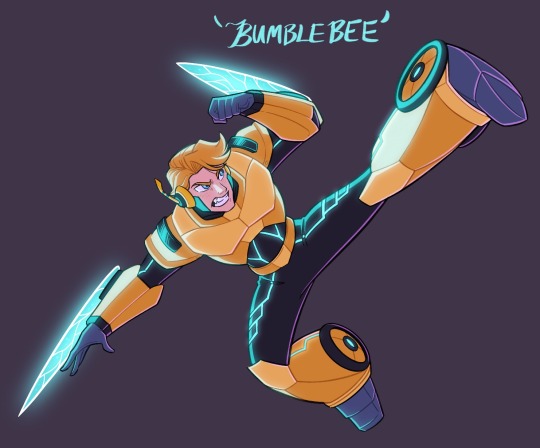
A lad finally gets some of that coveted spotlight!
Benjamin Bane (just Ben or Benji, thanks) may be the youngest of the active Autobot team as their sprightly scout who’s got a chip on his shoulder he wants to hurl into the next Functionist or Decepticon picking on him for his size, and who’s been through quite a bit despite his age, if the burn on his left arm, the slide bite on his right hand and the multitude of old cigarette burns he’s reluctant to explain are anything to go by.
When not on the field, he’s an avid dancer (with a love for ballet, something he could only pursue in secret until recently, and something which forms the core of his offensive style) and a good enough artist that he, alongside Mirage, are the two assigned to decorate armor for the team.
His smiley, chirpy facade hides quite a couple of issues, including PSTD and self-esteem issues, anxiety attacks, and an urge to please those he trusts even if it comes at his detriment.
More to his story below. (TW for child abuse)
Benjamin Bane (Bumblebee) would be hard-pressed to come up with a single good memory concerning his biological family during his childhood, and not for the lack of trying.
Born to an upper middle-class family in New York comprising a bullish, hot-tempered police sergeant father and a housewife mother, he grew up in the shadow of the son his father, who came from a family of law enforcers, wanted him to be in order to carry on the family legacy.
That he was a gentle, bubbly, sensitive child who loved following his mother around in the kitchen and spending his free time drawing did not bode well for the image his father wished to portray, and it didn’t take long for the discipline intended to mold him into a ‘man’ to become horrifically physical when he was barely five.
His mother, already used to his old man’s temper and quick hand, would often step in to take the punishment meant for him whenever he did something undesirable, though she couldn’t save Ben from the man’s wrath completely, and by the time he was nine, he was never seen without a hoodie in school and had perfected every excuse he’d been told to repeat when asked why he could not take it off or why he would come in on some days with a split lip.
He was small for his size, quiet, and took great pains not to be noticed, which had the opposite effect of making him the target of every other larger child looking to blow off steam, and he became good at running.
Really good.
There was no running from home however, home where the walls were insulated so neighbours wouldn’t hear what was happening within, and while some days would be better than others, there wasn’t a moment that he didn’t break into a cold sweat whenever he heard his father’s footsteps approaching his room.
With his mother unable to bear more children due to an illness, his father furiously continued with the campaign (sometimes the carrot was used though mostly it was the stick) to mold him into the son the man wanted, so he could make the cut during the streaming process prior to high school where students would be sorted into their future occupational classes.
What support he might have had from his mother in his young years also evaporated, as she pushed him to be the son his father needed him to be to keep the peace, putting the weight of the household’s sanctity on his slight shoulders.
He was forced into marksmanship lessons (where his first attempt to fire a gun went awry and left him with a deep slide bite wound), multiple self-defence classes to toughen him up (helpful for bullies whenever they didn’t come in packs), and a series of workouts to encourage a growth spurt so he could catch up to other potential cadet candidates.
The little sliver of hope that he would be good enough to make the junior police cadets went up in smoke when he was assigned to the manual class instead, owing to his size and his visceral aversion to handling firearms.
Branded as worthless and only good for paying off the ‘debt’ accumulated from the classes his father had earlier forced him into, Ben entered high school with his self-esteem scrapping at topsoil and digging deeper, and had it not been for a chance encounter with another boy who was evading a group of military-classed students intending to instil a lesson about talking back to those higher in the hierarchy, it might have dug itself into a grave.
The boy, who introduced himself as Guillermo ‘Memo’ Gutierrez after Ben dutifully sent the bullies scattering, was also assigned to the manual class and both of them decided to stick together for safety in numbers.
Ben had ruefully accepted his lot in life after years of being broken and beaten down. Memo, however, had a loving and supportive family; this kept the spark of his defiance to the system alive and he kindled it in Ben’s by giving his friend a safe space to escape to whenever the situation at Ben’s home became too intense.
Among Memo and Memo’s family was the first time where Ben opened up about his interests, could speak freely and found acceptance for what he liked and who he was.
The desire to reclaim the things he loved pushed him to seek out part-time work, which he eventually found after befriending a girl, Charlie Watson, who had helped put an end to the harassment he and Memo endured at school by playing the hierarchy to their favour and wielding her Navy ‘prime-pick’ status.
That she actually wanted nothing to do with the class she was pushed into (Navy) and wished to pursue a career in automotives despite parental objections was something that she and Ben bonded over, and she brought him to the scrapyard her uncle ran where he found work sorting out car parts and helping perform repairs.
He began to pursue art and dance in secret with part of his pay (keeping his sketchbooks and supplies at Memo’s place and taking dance lessons under the guise of after-class study sessions), while saving up the rest and planning for the day he would eventually break free of his father, ‘debt’ or no ‘debt’.
During this time, he subtly packed away important items and was careful not to anger his old man more than his mere presence already did on a good day——something which would become increasingly hard when the Clampdown began.
He would hear his father rant over the dinner table about how ungrateful the protesters who were made up mostly of the Manual Class were, how they weren’t worth the safety net they were demanding for the job they were doing, how they needed to know their place.
He would hear, as time went by, about how his father would beat the ones who were arrested, and more than once, how he would be killed if he, as the man’s son, ever did something as stupid and insolent as that.
He bit his tongue through all this and reluctantly refused Memo’s offer to join a peaceful protest for better wages and workplace compensation.
The protest turned violent after police assaulted those taking part however, and as he watched the news hoping to see if Memo was alright, he saw his friend among those who were tossed into the dreaded black vans to be brought over to stations for interrogation.
His father, fielding a call from a colleague about the batch of protesters being brought in, told them to separate the adults from the teenagers, who would be easier to break, and it was at this point Ben’s spark turned into a bonfire.
As his father got dressed for work, he crept into the man’s study and managed to figure out the combination to the safe where the man’s gun was kept, retrieving it and aiming it at the police sergeant who came in and demanded for him to stand down.
Ben, in turn, demanded for his father to call the station and have Memo released, and when his father laughed at his audacity, mocked the way his hands shook while he was holding the gun and threatened to beat him senseless once this was all over, he shot the man close enough to the head to clip an ear to prove a point, before repeating his demand again.
This time, his father complied and called the station to order for Memo’s release; Ben’s relief however was all the momentary lapse of guard that his father needed to rush in and attempt to wrest the gun back, and in the struggle, he accidentally shot his father in the knee.
Under the hail of threats on how he was going to die once his father got hands on him, Ben flung the gun where the man could not reach, grabbed one of the bags he had secretly packed and ran out of the house to the screams of his mother.
He called Charlie and explained the situation to her, as both of them made their way to the station where his father worked to pick up Memo, who was confused about the state of affairs.
At 18 years, Ben was now a fugitive who could no longer go home; Memo brought him to the manual class district where Ben could hide among allies, and it was here that he spent a few months in hiding, disguised as a manual worker.
However, still fully terrified at the thought of his father eventually hunting him down within the confines of the city, he made plans to leave and head to the West Coast, far away from any chance that he would meet his old man by accident on the streets.
To his surprise, Charlie and Memo elected to join him in the move, and the three of them left together on a Greyhound bus; Him to escape his father, Charlie to escape her future with a military complex which her father died for and Memo to protect his family after he was named a person of interest in the protest.
However, they were forced to stop in Texas when police were inspecting passing buses for runaway Cold Constructs. Here, they met Ian Hart (Ironhide), a rancher secretly helping Cold Constructs escape ownership by crossing over into Mexico to start new lives.
Ian, seeing how they ran from the bus, assumed they were young Cold Constructs and immediately took them in and offered them shelter; when they explained their situation, he kept his offer, letting them stay until they had their plans sorted out and paying them for work done on his ranch in the meantime.
All three of them grew fond of him and spent a month working on his ranch, helping out equally between his longhorn cattle and the Cold Constructs who would come in scared, starving, and seeking refuge from bounty hunters looking to bring them back to the establishments they were assigned to.
Someone however, had gotten wind of Ian’s clandestine operation, and the man was arrested during a midnight raid, though not before he flung Ben, Charlie and Memo into a secret basement with three Cold Constructs who he told them to help cross the border the next day.
They did as they were told, but decided to return to the ranch to figure out how to help Ian, and when they came back there, it was to come face to face with two strangers who were also seeking Ian after seeing him on the news.
These strangers introduced themselves as Omar Parvez (Optimus Prime), Jace Zayden (Jazz) and Preston Wan (Prowl), members of a rebellion that had sprung up in the UK, and upon hearing that they had been with Ian for the past month, requested for their help in tracking the man down to save him from a terrible fate at the hands of government interrogators.
Realising that they were now caught up in something bigger than they ever imagined, Ben nonetheless accepted the request, unwilling to stand back and do nothing while a good man suffered.
Youth, size and a lifetime of abuse would not be an obstacle to him helping someone else, especially with his best friends by his side.
#Maccadam#Humanformers#Bumblebee#Optimus Prime#charlie watson#memo gutierrez#Character Art#tw: abuse#tw: child abuse#tw: gun mention
880 notes
·
View notes
Text
Ironwood and Cinder: The Final Word
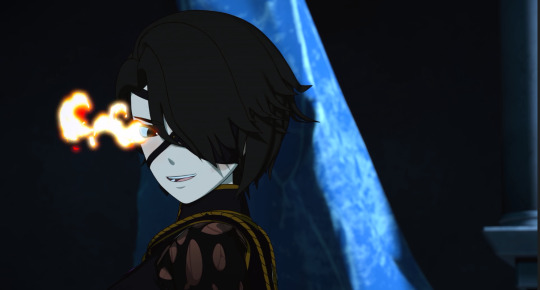
Cinder: And that’s… checkmate.
The Final Word of the volume is Cinder’s and it is meaningful she says it to Ironwood.
As a matter of fact Ironwood and Cinder are two sides of the same coin on many levels. This is conveyed also structurally.
Volume 7 is mostly about Ironwood’s tragic spiral. We are shown him struggle with his flaw throughout the whole volume, but in the end he loses to it and becomes just as dangerous as Salem:
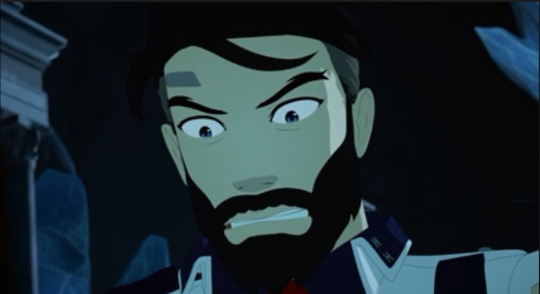
Oscar: Then you're as dangerous as she is, James.
Not only does volume 8 close with Cinder instead, but it also opens with her:
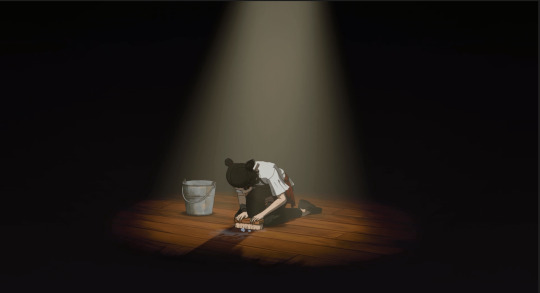
And it even gives us her backstory:

Why does it happen? And why is Cinder’s final line so important when it comes to her foiling with Ironwood?
GRAVITY

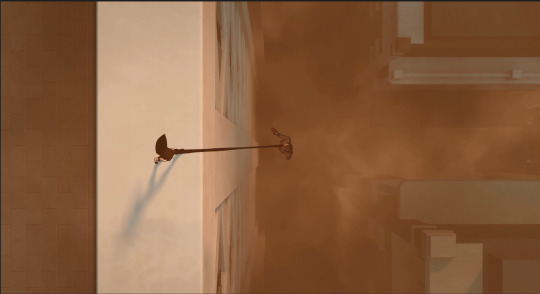
It is not by chance that Watts calls both Ironwood and Cinder out before the climax of respectively volume 7 (Ironwood) and volume 8 (Cinder). This is because, as stated above, volume 7 is Ironwood’s volume, while volume 8 is Cinder’s. So they both are confronted with a truth about themselves and their reaction to it influences their stories in the Atlas arc.
In a sense, even if Watts is the one dangerously hanging over an abyss... it is actually Ironwood and Cinder who are on the brink. They are deciding Watts’s survival, but they are also deciding their own destiny.
They are choosing if to fall because of gravity or if to fly in the sky victorious.
At the same time, the two scenes with Watts show how Cinder and Ironwood are both similar and opposites.
AS ABOVE, SO BELOW
Ironwood and Cinder are nothing, but two products of Atlas’s society.
Ironwood was born at the very top:
Watts: You just stood atop it and called yourself a giant!
Cinder existed at the very bottom:
Watts: You think you're entitled to everything just because you've suffered, but suffering isn't enough! You can't just be strong, you have to be smart! You can't just be deserving, you have to be worthy! But all you have ever been, is a BLOODY MIGRAINE!
Watts is in the middle and he represents the worst traits of both.
He wants everything, just like Cinder:
Ironwood: I gave you everything you could have wanted!
But differently from Cinder it was no true he had nothing. He was successful, had food, clothes and respect. Still, he was never satisfied and ended up disgracing himself in the search of something more.
He also disregards feelings in favor of rationality, just like Ironwood:
Watts: Our tin soldier’s heart has cost him his mind.
And he sees people under him as inherently inferior:
Watts: Yes, yes, please keep your posse in check.
This is why his death is fitting:
Cinder: I merely added more flames to the fires of Atlas.
He burns with Atlas aka the city he wants to destroy, but also a symbol of who he is deep down.
What is more, his death happens specifically because he blindly follows his wishes:
Watts: Oh, believe me, this is everything I've ever wanted.
And because he is outsmarted and manipulated by Cinder:
Cinder: You deserve this, Arthur. We'll be back.
He is proud of his genius and rationality, but in the end he dies because of his feelings of pettiness.
In short, Watts, Cinder and Ironwood represent three social classes of Atlas and how the system corrupts people at every level. In general, all three want to be at the very top, but disreguard and mistreat the ones below.
-This is why Ironwood seeks control even in situations where he is not in charge, like the Vytal Festival. He also challenges Ozpin’s authority and leadership because he is not used not to be the one deciding. At the same time, he is shown ready to discard Mantle in multiple occasions.
-This is why Watts can call out Ironwood’s arrogance without seeing he is exactly the same as him.
-Finally, this is why Cinder lashes out at people she sees as Atlas elites (the Schnees, Ironwood, Watts), but treats those below her just like she was treated:
Emerald: We don't need him! Everything was going fine! (a slap is heard, and she cries out in pain)
Cinder: Do not mistake your place.
Mercury: Oh yeah? Tell that to--
Cinder: Quiet.
THE ENEMIES OF TRUST
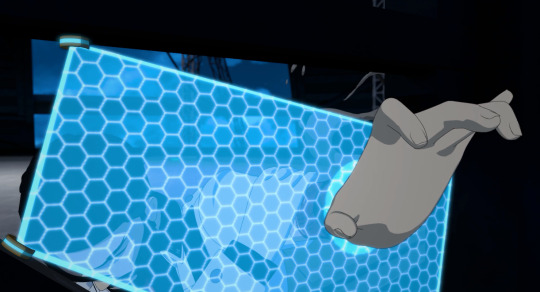

Both Ironwood and Cinder’s left arms are artificial. Ironwood’s is mechanical, while Cinder’s is Grimm.
Their respective arms convey opposite approaches to things.
On a more general level, they are respectively linked to Creation (Ironwood’s mechanical arm) and to Destruction (Cinder’s Grimm arm). As a matter of fact a robotic arm is a human creation, while Grimms are nothing, but the symbol of destruction.
On a personal level, their arms hint at the two characters’ opposite personalities.
Ironwood’s arm can’t feel pain.
Cinder’s is instead linked to pain and feelings in different ways:
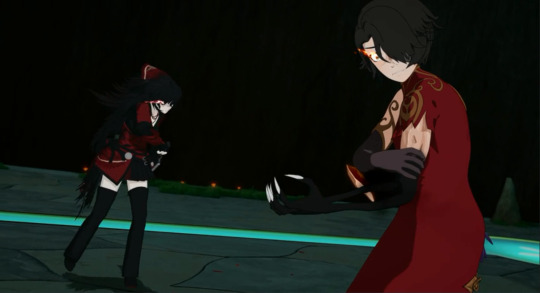
Raven: Aura can't protect your arm, it's Grimm.
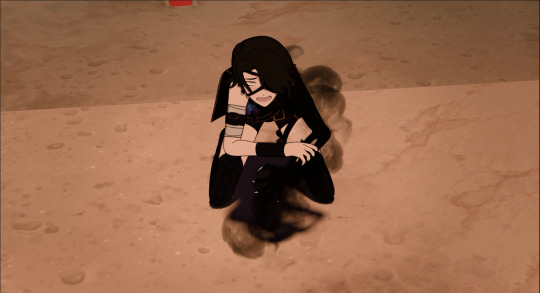
Salem: You chose to disobey my specific instructions just to fail again.

Cinder: She’s back…
Cinder feels great pain whenever her Shadow Hand is cut because she can’t protect it with aura. At the same time, it is used by Salem to torture her. Finally, it links her to Salem to the point that she knows when her Master is back.
In other words, Cinder’s arm lets her feel more, while Ironwood’s lets him feel less.
This difference is mirrored by both the ways Ironwood and Cinder respectively attack Watts and by their semblances:
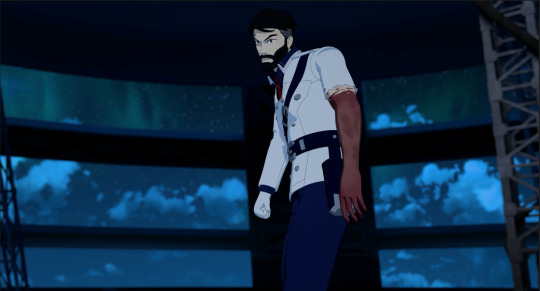

Ironwood’s Mettle lets Ironwood suppress his own feelings, so that he can pursue any objective, no matter how cruel or immoral it is. It makes him “superhuman”, but in a very negative sense.
Cinder’s Scorching Caress represents Cinder’s explosive emotions. It is a form of self-expression, which is both destructive and self-destructive.
Ironwood’s semblance is about repression, while Cinder’s is about lashing out.
Similarly, Ironwood goes after Watts at the cost of his arm and he ignores the pain he feels:
Watts: I wouldn't do that if I were you. I mean, unless you're hoping to add more metal to that body of yours.
Cinder instead goes after Watts to vent her anger:
Cinder: What do you mean, she'll destroy herself? How am I supposed to take her power if she's dead?!
Both are extremes and both are wrong, as Winter explains:
Winter: But yes Penny, we must still acknowledge our personal feelings, wrestle with them. It ensures us that we’re on the right path. It’s what makes us human.
Ironwood and Cinder should aknowledge their own feelings not to be consumed by them. It is also the only way for them to truly be humans, not machines or monsters, but simply people.
Both characters almost succeed just before the climax of their respective volumes.
Ironwood tries to open up to others:
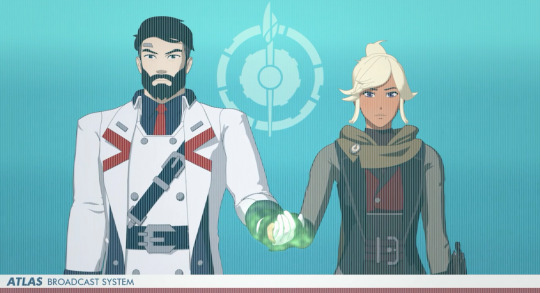
And Cinder shows vulnerability:
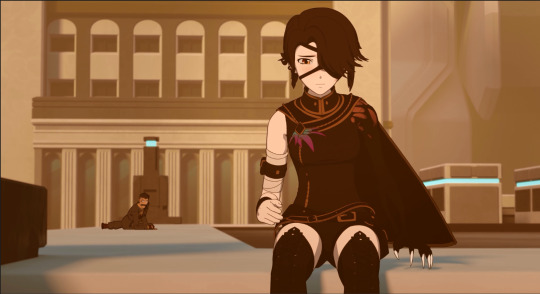
However, none of them is able to capitalize on this chance for development. This is ironically because of each other:


Cinder messes with Ironwood’s insecurities, while Ironwood’s ultimatum gives Cinder the perfect chance to ignore hers.
The result is that Ironwood goes back to control, while Cinder goes back to manipulation. Both do so because they are unable to trust.
Interestingly, they take after their respective mentors in this.
Ironwood takes after Ozpin:
Ironwood: Did you really think you were the only one who got to work on a new plan after Beacon? WIth Ozpin gone, I needed my own team of people I could trust.
Oscar: General? Earlier, you asked for my advice.
Ironwood: I wanted Ozpin's advice.
Oscar: And his advice probably would've been to keep your secrets.
Cinder takes after Salem:
Salem: When I chose you as my vessel for the Maidens, I put my trust in you. So, I trust that you wouldn’t possibly return to me empty-handed.
Ironwood’s whole struggle in volume 7 is his search for a “new approach”. He wants to be like Ozpin, but better. This is why he founds his own group, but wants to trust the world with the truth about Salem. However, he confuses trust with control.
Cinder instead wants to become just like Salem and suffers when she sees she is not. This is why she collects assets, just like her master. This is also why she does not trust anyone, but manipulates others.
That said, what is the difference between Ironwood’s control and Cinder’s manipulation? It has once again to do with feelings.
Ironwood’s attempt to manipulate others is about suppressing feelings. He uses Atlas’s military hierarchy and social structures to ask for his subordinates’ blind loyalty.
Cinder’s method to control people lies instead in making use of others’ feelings. She uses both wishes and fears to her advantage.
In short, control and manipulation are nothing, but the same inability to trust declined in opposite ways. They are both “enemies of trust”.
This is why both Ironwood and Cinder find a strong enemy and a foil in the character, who embodies friendship in these volumes:

Deep down, Ironwood and Cinder not trusting others is because they fear betrayal:
Cinder: I won’t have to run now.
Rhodes: That’s all you’ll ever do.
Ironwood: I've chased a lot of shadows over the years, always expecting betrayal. But never once did I think it would ever come from you.
However, Penny too is betrayed and mistreated by others:
Penny: I do not like it when friends fight.
Ruby: I know. Yang and I may not agree on how best to save Mantle but-
Penny: No. I mean Winter. The general. They were our friends. But then the Ace Ops attacked you. And the general, he said people were going to die, because of me.
However, she does not give up on the ideal of a genuine bond:
Attached but not By strings
Still, if Penny is a positive foil to both Ironwood and Cinder, why does she die?
RISK
Weiss: Trust is a risk.
Yang: Ruby, they’re not called sure things, they’re called risks.
These two lines taken together are why at the end of volume 8 Penny dies, our heroes fall and the manipulative Cinder wins.
It happens to show the main theme of the two Atlas volumes. Trust is not a “sure thing”. It is a risk and it does not always work. Still, it is necessary to trust as it is necessary to take risks:
Yang: You were being optimistic. Look, blind optimism isn’t great, but no optimism means we already lost. We need hope. We need to take risks.
Giving up on trust and risks means giving up on hope. It means to give in to fear.
Still, this does not mean your trust will always be paid back. And it does not mean that the risks you take will always work, even if you come up with a wonderful plan:
Cinder: I knew your plan would be bold, but I never could have predicted all of this...
Sometimes people will betray you:

Sometimes your risk will end up in a fall:

However, it is still worth to trust, even when you have no guarantee it will work:
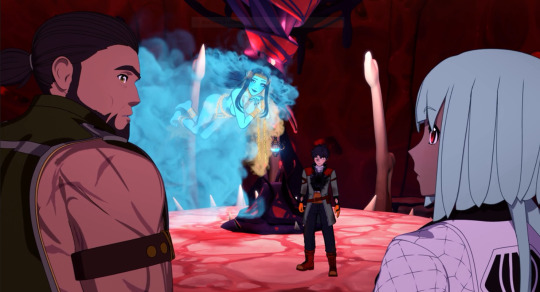
And sometimes It is even worth to risk the fall because it may lead to people being saved:
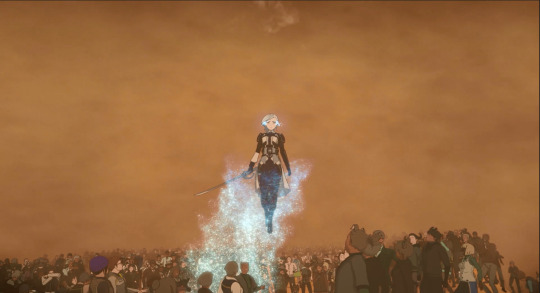
This same idea is conveyed also through Penny’s final choice:

Penny: Trust me.
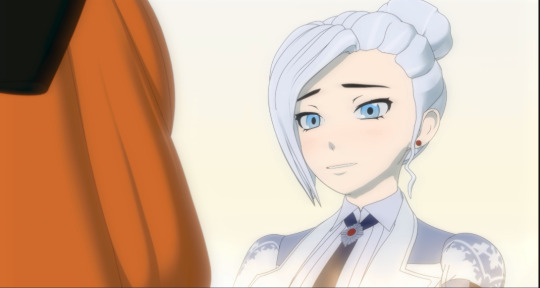
Winter: Thank you for trusting me with this.
Penny dies tragically, but she still manages to pass the Maiden’s power to a person she trusts.
This is especially meaningful because the Winter Maiden power, just like Penny herself, has been subjected to both control and manipulation.
Ironwood does all he can to make sure the power ends up to Winter. At the same time, he is the one most responsible for Penny feeling as nothing, but a robot:
Ironwood: As the official report stated, that footage was doctored. Penny is completely under my control.
Cinder tries to steal the power three times. She also manipulates Penny’s feelings towards her friends:
Cinder: I was hoping your friends would be here. But it looks like they left you to do all the work. You’re just a tool to be used!
In the end, Ironwood treating Penny as a machine (control) and Cinder using Penny’s love for her friends against her (manipulation) are among the psychological factors that lead Penny to be mortally wounded by Cinder.
Still, while dying Penny negates both Ironwood and Cinder and frees the power and herself from both control and manipulation.
The fact she chooses Winter works well to illustrate this.
Winter is the person Ironwood wants as the next Maiden. However, Winter becomes a Maiden not because of Ironwood’s control, but because of Penny’s trust:
Ironwood: So… the destiny I chose for you has arrived.
Winter: You chose nothing. This...was a gift.
Winter is a Schnee, so she represents both what Cinder hates and what she herself wants to be:
Cinder to Winter: You Atlas elites are all the same! You think hoarding power means you’ll have it forever, but it just makes the rest of us hungrier.
Winter is a symbol of Atlas and so she is a reminder to Cinder that Atlas is not really destroyed:
Robyn: What do you think a kingdom is? The people, or just the chunk of land they live on?
Just like Cinder’s past isn’t.
WORTHY
Cinder wants to be worthy. Ironwood wants to be a hero.
Deep down, Ironwood and Cinder want the same thing. They want to be above others. They want to be more than humans.
However, they go at it in opposite ways:
Ironwood: I have sacrificed everything!
Cinder: I want it all...
Ironwood thinks that victory lies in sacrificing everything, while Cinder sees it as taking it all.
These opposite viewpoints mirror their respective social stances.
Ironwood can say he wants to sacrifice everything because he has everything.
Cinder thinks happiness lies in everything because she has nothing:
Cinder: You’re right. Without you I am nothing. But because of you, I am everything.
In the end, Ironwood and Cinder are each other’s true enemies, but they fail to see it and lash out against the wrong people:
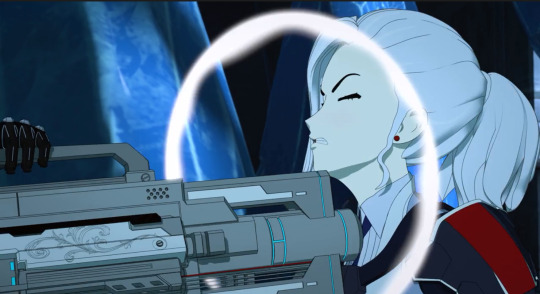
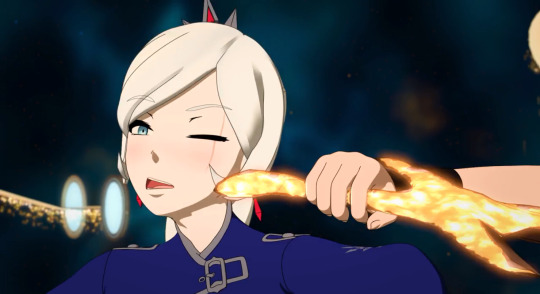
Ironwood and Cinder’s respective fight against Winter and Weiss is exactly this.
Ironwood fights a Maiden he sees as an enemy of Atlas, while another Maiden is attacking the people he swore to protect.
Cinder lashes out at Weiss because of her origins, while Weiss has decided to leave her status and money behind to make the right thing.
Still, Ironwood and Cinder are too hypocritical to see the truth. This is why they attack people, who could have helped them, if they were given the chance.
This is also why they receive a warning:
Winter: No, you have sacrificed everyone else!
Winter: You… are going to pay… for everything you’ve done!
Ironwood claims he is ready to sacrifice everything. However, he never sacrifices himself:

In the end, he is unable to sacrifice his life to fight Salem.
Let’s highlight he has nothing to lose by this point. He is falling with Atlas anyway. In his final moments, he is given the chance to prove true to his words:
I would die Without regret, I’d offer up my life With zero reservations I would fly Into the sun If that would keep our dream alive
Instead, he gives up. He has been shooting his allies until the very end, but freezes in front of his enemy.
Cinder thinks she is closer to her final victory, but in the end she has accomplished nothing of what she truly wants.
She wants to kill RWBY, but they are alive. She wants the Maiden powers, but she fails.
At the same time, Cinder is still far away from what she truly needs:
Cinder: You have everything you need?
Watts: Oh, believe me, this is everything I've ever wanted.
She is given a perfect mirror of herself in Watts. Still, instead of seeing it, Cinder uses his flaw, which is her same flaw, to kill him. Watts’ wants lead to his death and the same thing might happen to Cinder if she does not stop herself in time.
Finally, there is this:
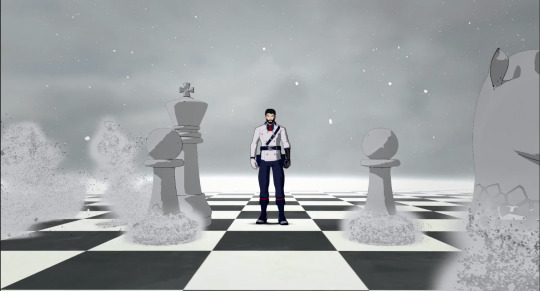
Salem: This game is not yours to win, Cinder, it’s mine. Just because you’re more valuable to me than a pawn, does not make you a player. Everything is already in motion. All you need concern yourself with is your ability to act when I tell you to.
Ironwood and Cinder share a chess motif.
Ironwood thinks of himself as a player and specifically as Salem’s opponent.
Cinder is instead told she is no player.
However, in the end, Ironwood becomes a mere pawn to the point that all Watts has to do is to open his cell to be sure he is going to unwillingly aid in Cinder’s plan.
What is more, he is so fixated on Salem that he fails to aknowledge the people below him. This is why his true opponent is a slave that Atlas exploited.
Cinder frames herself as a player instead. She is the one who truly makes the first move against Ironwood and ultimately she is the one who defeats both him and our protagonists. Finally, she is the one who calls checkmate.
Still, is she really playing her own game?
In the end, the one who gets what she wants is not Cinder, but Salem:
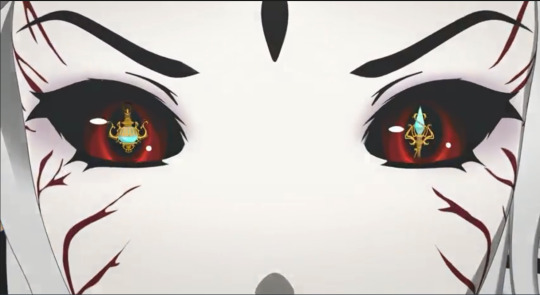
And all she has to do to obtain it is one small move:

Salem: And I’ve realized, it’s all my fault. You’ve fought your whole life unwaveringly for what you want and here I am holding you back instead of lifting you up.
While Cinder is once again letting her talent be exploited by those above her. She is choosing to be Salem’s Queen instead than a player of her own life.
She is the Black Queen defeating the White King, but nothing more.
256 notes
·
View notes
Text
Persona World’s Demon Encyclopedia

Persona 1 and 2 do not have a compendium. The closest thing we got in-game are the small blurbs on the Analyze screen in P2... and the closest thing to an actual compendium is the Demon Encyclopedia at the end of Persona World.
I’ve translated some of those entries in the past for the Megaten Wiki, but now I intend to translate everything. That’s right, I’ll translate everything - one entry per day.
So, have this initial dump of profiles I’ve translated in the past few days and see you tomorrow for more! (I’m also posting the translations on twitter, for those interested)
Afanc
A giant beaver monster. It dwells in the Conwy river, which is located to the north of Wales.
It creates whirlpools and drags down those who look into them. Furthermore, the Afanc is strong enough to overpower a group of adult men.
However, it is weak to maidens. By using one as bait, it’s possible to lure Afanc into a trap and capture it.
Archangel
Angels originating from Israel. It is said that they carry out the Lord’s Divine Will.
There are many theories as to what their role is, but the most commonly accepted one is that Archangels hold a high position in Heaven’s hierarchy and are tasked with communicating the Divine Will to humans.
They are said to command nine armies of angels who fight against the armies of demons that try to guide humans down to Hell.
In ancient times, Archangels were considered the topmost position of the divine hierarchy, but during the Middle Ages many classes above them were created --such as the Seraphs and Virtues-- which knocked the Archangels down the list.
Arthur
The main character of the Arthurian Mythos, Arthur was an English hero from the Middle Ages.
It is said he went on expeditions both in and outside the British Isles, all the while accompanied by his loyal Knights of the Round Table.
He won multiple battles with the help of Merlin, his strategist and court mage. After successfully establishing his kingdom, Arthur began to expand its borders, and eventually conquered both Scandinavia and Rome.
According to the legends, Arthur possessed a multitude of weapons, including: the legendary sword Excalibur, the spear Ron, and the shield Prydwen, the latter of which depicts an image of the Virgin Mary.
It is believed that, out of all characters depicted in the Arthurian Mythos, only a few of them actually existed, but even so there is little historical evidence to back up this claim. Those characters are: Arthur, Mordred, Ambrosius, and Aurelianus.
Armaiti
Exemplary goddess from Zoroastrianism. She is a member of the Amesha Spenta, the children of the chief god Ahura Mazda.
Her name means “devotion,” and as such she represents godly and spiritual harmony as well as faith itself. She laments acts of evil and rejoices when those who follow the divine will cultivate the earth or have children.
Aizen Myouou
A Wisdom King of Buddhism born in India.
He rules over human lust and passions, and is also responsible for purging that lust. He’s also worshipped as the guardian deity of shops who work with indigo dye.
Aizen Myouou’s face is always depicting an angry expression, with his three eyes wide open and his hair standing up. His six arms are dyed red with the power of passion.
Aeshma
One of the seven demons of Zoroastrianism and a follower of Angra Mainyu. He rules over wrath and lust, enchanting people into performing evil deeds.
He’s always being pursued by the angel Sraosha. Whenever Aeshma does an evil deed, Sraosha will descend from the heavens to fight him.
Aeshma is also stated to be the archetype of the Christian demon Asmodeus.
Aello
The oldest of the harpy sisters from Greek mythology.
Her name means “storm-swift,” and as it suggests she is a spirit of storms and dust devils. Similarly to her fellow harpies Ocypete and Celaeno, she’s commonly depicted with a human head and a bird’s body.
She’s a servant of the sun god Apollo, and will sometimes carry out divine punishment in his stead.
Red Cloak and Blue Cloak
Spirit that appears in school bathrooms.
It will ask the following question to those who enter the bathroom: “Do you need a red cape? Or do you need a blue cape?”. If a person picks “red” they will become a bloodstained corpse, and if they pick “blue” they will become a corpse whose blood has been completely drained.
Argetlam
From Celtic mythology, this is another name for Nuada, the king of the Thuata De Danann. He has shining golden hair and wields the magic sword Claimh Solais.
He had one of his arms cut off during combat, and was given a silver prosthetic arm by the god of medicine. “Argetlam” means “one with a silver arm” and is from this incident that Nuada gained this second name.
Argetlam was killed in battle by the evil dragon Crom Cruach, which was summoned by the Fomorian king Balor.
Agathion
A general term for incorporeal familiars.
When employed by a magician, Agathion will do anything it is ordered to, from cursing people to household chores. Also, it will disappear in the blink of an eye once it has fulfilled its duty.
Since Agathion has no real form, it takes a different form each time it is summoned, such as a small bird or animal. It can change its size freely, allowing Agathion to hide inside small objects such as bottles, amulets, rings, etc.
Alladin’s genie in the lamp from Arabian Nights can be considered a kind of Agathion.
Agrippa
Heinrich Cornelius Agrippa.
A German alchemist and researcher of witchcraft and secrets who was active during the Renaissance. He wrote On the Vanity of the Sciences and the Arts and was known as the greatest magician of the Middle Ages.
He caught the eye of people by, among many things, arguing in favor of separating magic from demons, combining Kabbalah and Hermeticism together, and also his theories on the structure of the universe. He was also the first one to point out the existence of spiritual power in humans.
Agrippa was born in Cologne, Germany in the year 1486. After graduating from Cologne University, he served under Emperor Maximilian I. For a brief period, he worked as a lecturer in the University of Dole, but was forced to leave under suspicions of being a heretic.
After that, he wandered through many countries such as England and Italy working as a doctor for the nobility, but never managed to stay in one place for too long due to his short temper. He passed away in 1535, in the city of Grenoble.
See you tomorrow for: Azazel.
#persona#persona 1#megami ibunroku persona#persona 2#shin megami tensei#smt#tagging it as smt cause this is about demons too#demonic compendium
30 notes
·
View notes
Text
Posting this for @pilotkinkade in response to their recent post made here, regarding concerns about VLD and how it includes white savior complex or potentially smears Allura’s character with that complex. I’m not reblogging directly because this is a long response lol. Thank you pilotkinkade for chatting earlier; I hope you find this post interesting at least and would be curious of your thoughts in return!
---
I do agree with your general sentiments, that VLD takes on a disquieting savior complex throughout a good portion of the show, even more so than in previous Voltron iterations. For me, it feels most apparent in the way that Voltron as an all-powerful machine in VLD is piloted by its second generation.
To compare: In the original OG alliance (Alfor, Zarkon, Trigel, Gyrgan, and Blaytz), multiple major races were represented, functioning as one to save their own collective galaxy from threats. So even among the OG paladins, there were checks and balances (maybe Zarkon had the strongest military skills personally, but Alfor had the alchemy, etc.), with mass racial diversity. This seemed like a pretty innovative and cool addition to the Voltron franchise. The s3 finale also clarifies that, unlike VLD’s second-generation, all of these paladins were leaders of their people. This meant they had political and legal authority/experience that an average warrior or citizen wouldn’t.
By removing that whole structure and retrofitting Voltron with (mostly) a group of unprepared teenagers from a single planet entirely uninvolved in the universal conflict, it created a lot of strange hierarchies...
We see much of the known universe raise up people who had zero prior experience with war, and little to no military or diplomatic training, as well as very little awareness of the traumas or people groups involved in this war. (Shiro is possibly the exception here.) But suddenly, all of these paladins also had unfettered, largely unquestioned access to ultimate power to carry out whatever vision they felt was right in the moment. Because simply “might is right,” we see even highly experienced commanders like Kolivan become castrated in authority compared to Team Voltron. Various alien groups express upset or side-eye Team Voltron’s well-meaning actions but obvious insensitivity to/ignorance of their problems or fears. Even at the paladin-level, a princess trained to fight and lead is subordinated to a boy with zero leadership training whatsoever (which is very different from previous iterations where Keith was actually very competent, more experienced, and wanted to be a leader).
And when Voltron plays the unchecked judge, jury, and executioner across the entire universe, the new paladins as a whole also do not have the political or legal authority the OG pallies did in the boundaries of their own galaxy. The second-gen paladins are not authorities of their people or representative of the people groups affected in the war they’re now leading. The OG pallies built the actual legend of Voltron in less than 28 decaphoebs, clearly going beyond their 5 nations to help others suffering from natural disasters or unknown needs, which might raise some eyebrows perhaps because we don’t know what all that entailed. But while we see that the Voltron machine eventually got celebrated, the OG pallies are never shown personally soaking in some kind of savior celebration…



(Photo ID: Alfor says, “Why I joined up this band of scoundrels, I’ll never know.” Trigel responds, “Because we’re the only band of scoundrels that would have you.” Third screenshot is of the paladins celebrating their alliance win by themselves.)
…compared to second-gen paladins (or some anyway) who pretty clearly soak in the love and prestige they’ve received based off the historical and legendary precedence of the OG alliance’s work:

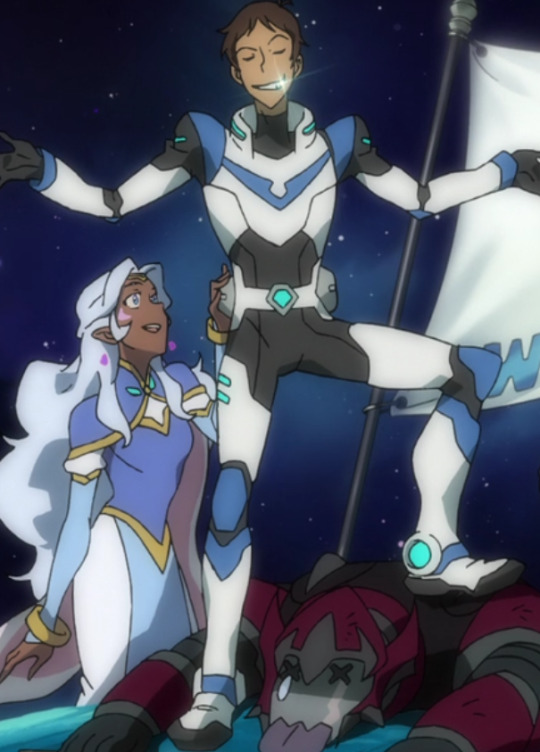
(Photo IDs: Lance taking selfies with aliens excited to be around paladins. A second screenshot of Lance daydreaming about being a universal savior, stomping on Zarkon, planting a flag to mark ownership, and having Allura stare up at him in worship.)
In fact, a lot of the pro-Voltron war propaganda relies heavily more on recreating the legend already built for them, than on the actual competency or experience of the current paladins:
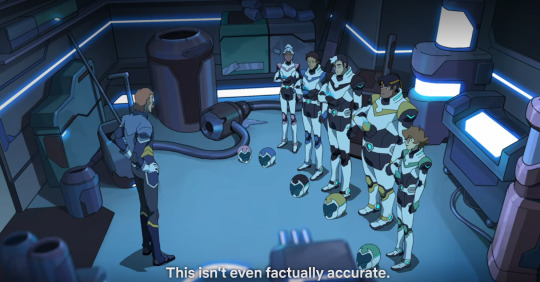

(Photo ID: Pidge complains about the war propaganda scripts, “This isn’t even factually accurate.” Coran replies, “Well, this is the Legend of Voltron, not the documentary of Voltron.”)
On that note, we even see the scripts reverse who is actually the most competent or capable of performing.


(Photo ID: Coran says, “Ladies and gentle-aliens, bear witness as the Paladins of Voltron attack Zarkon’s base to save the helpless Princess Allura!”)
Coran’s script, however well-meant, pretty massively infantilizes Allura as someone who needs to be saved by an external force, rather than mentioning her as someone who is an active and critical ally of the Voltron paladins in this war.
Unlike Coran’s script, Princess Allura isn’t helpless. In terms of the second-generation paladins, she’s has the most war-time experience, and is also the one that the paladins lean on constantly to create a meaningful connection with other people groups who are otherwise hesitant about Voltron.
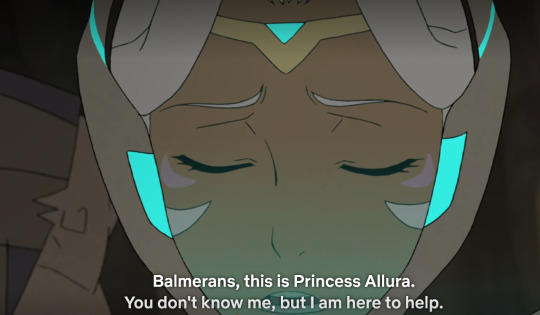

(Photo ID: Allura speaks to the Balmeran people, “Balmerans, this is Princess Allura. You don’t know me, but I am here to help. I know what it’s like to watch your home planet die.”)
Allura is the successor to the Altean monarchy and a direct victim of the OG galaxy wars. So unlike other second-gen paladins, she has some semblance of legal/political authority that she was actively trained for, as well as personal skin in the game. She is ultimately the only paladin who has experienced a mass omnicide of her home and people, similar to other victims of the Galra regime. She also still accepts the authority of her father, whose AI tells her in season 1 to be prepared to sacrifice everything to undo his mistakes.
We see Allura from that point onward functioning under that directive from her father and king—to sacrifice everything she has to end Zarkon’s regime. One could potentially make the argument that, within this structure, Allura might suffer from a certain subset of “white knight syndrome,” in which one feels they’re worthless if they’re not sacrificing for others. If I have my facts right, it’s a different psychological state from white savior complex (in which I define white savior complex as “when someone outside the issue at hand barges in to make a change that may or may not benefit the recipient, simply to make themselves feel better or appear useful, without regard to the recipient’s wishes or real needs”). But I feel even the comparison of “white knight syndrome” gets dicey. Because Allura is shown as acting happy without necessarily sacrificing things (in fact, she acts progressively depressed s7-s8, the more she has to give up intrinsic things about herself or her identity). But when Allura chooses to assist or sacrifice, the sacrifice she makes has a very relevant and functional impact for the people she helps.
In season 1, she chooses to sacrifice herself to save Shiro. Shiro was, at that time, the Black Paladin and leader of Voltron, so Allura saw herself as functionally the less important of the two to save since she did not pilot the universe’s only weapon against Zarkon.
With the Balmera, she similarly chooses to act because the Balmerans themselves acknowledge they are entirely out of options, and also because the Balmerans (and the Balmera itself) accept her help she offers. At this point in time, she has already established a deep personal connection with them by virtue of their shared trauma of losing their home planets.
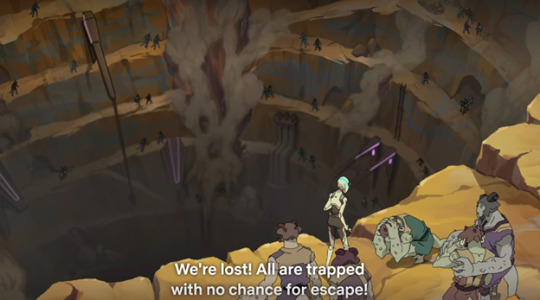


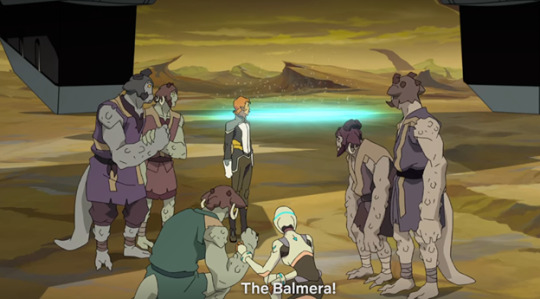
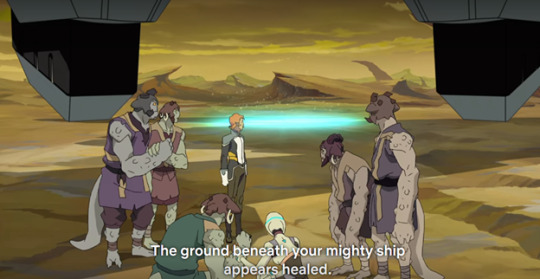
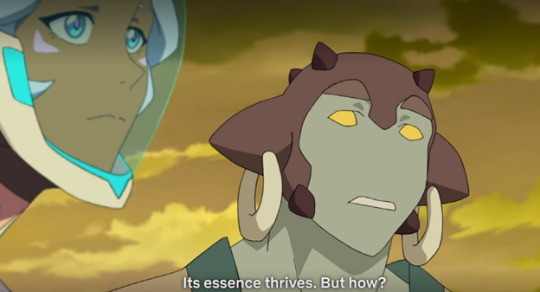
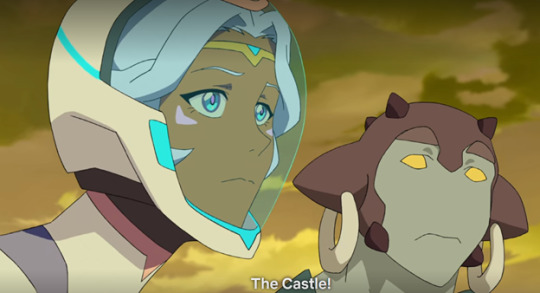
(Photo IDs: Shay says, “We’re lost! All are trapped with no chance for escape!” Allura says, “We can’t give up.” Shay responds, “But what can be done?” The group realizes the Balmera is regenerating beneath the ship, and Shay wonders why. Allura says, “The Castle!”)
Here, Allura assumes that the Castle—which is powered by a Balmeran crystal itself—could be regenerating the Balmera. But a Balmeran elder corrects her:

(Photo ID: A Balmeran elder says, “Not just the Castle, but you, as well.”)
So Allura did not even recognize at first that she was in any way a part of the solution to the Balmera regenerating.
Regarding the Balmera act itself, I’m not sure it satisfies the conditions for a white savior complex? I’m curious about your thoughts here, because I guess I saw it happening differently, from a witchcraft perspective...
We know from both Coran and Shay that originally, Alteans were one of the historical races who sacrificed some of their own energy to replenish the Balmera when seeking a crystal:
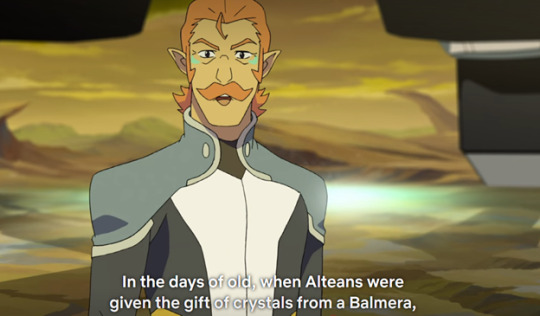

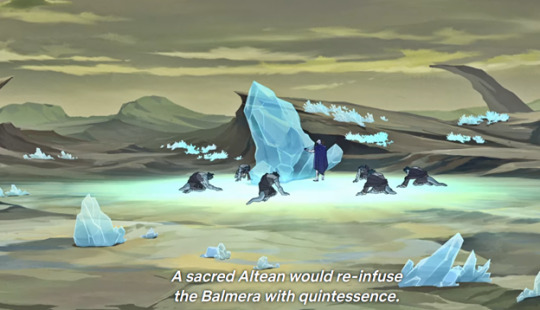
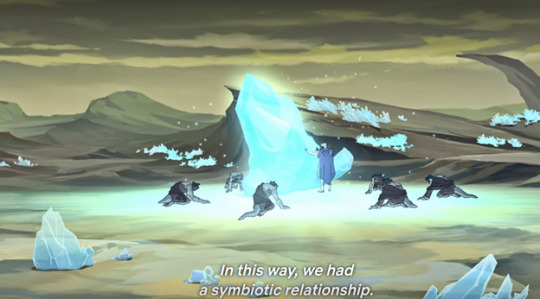
(Photo ID: Coran saying, “In the days of old, when Alteans were given the gift of crystals from a Balmera, we would repay its sacrifice by performing a ceremony. A sacred Altean would re-infuse the Balmera with quintessence. In this way, we had a symbiotic relationship.”)
We see that Balmerans were a voluntary part of this energy exchange by virtue of their unique connective powers (which is likely why we see them kneeling and activating said powers during these ceremonies).
Shay herself seems to indicate she is highly aware of these old ceremonies:
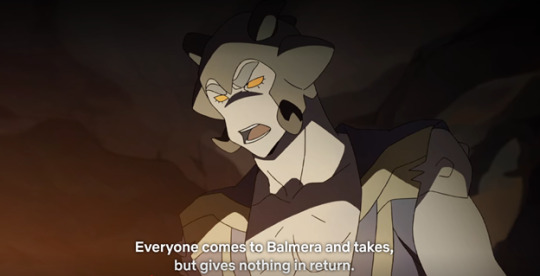
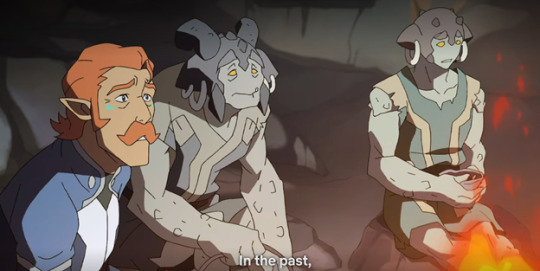
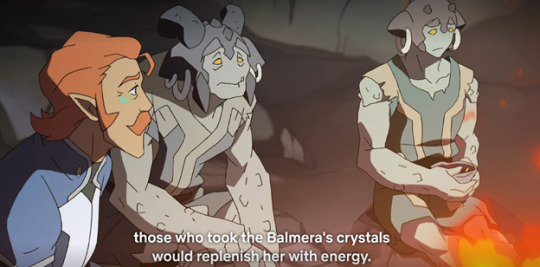
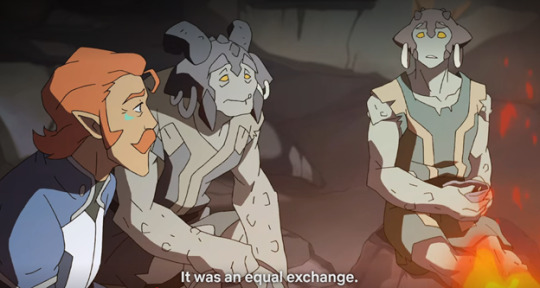
(Photo ID: Rax says, “Everyone comes to Balmera and takes, but gives nothing in return!” Shay says, “In the past, those who took the Balmera’s crystals would replenish her with energy. It was an equal exchange.”)
Shay agrees that the ceremony itself involves a sacred exchange of life force.
So I would argue that in this case, the Balmerans are not kneeling to Allura specifically or worshiping someone—it seems to be just the imagery associated with magical spells/magical transfers (where one object in the middle is the main conduit/focal point, and the other objects surrounding help to create and sustain the spell/protective barrier, etc).
One of the basic practices in real-world witchcraft is casting a magic/ritual circle. The circle creates a space where the spell, ritual, or form of protection can be performed. Forgive the stock image, but here’s just a super basic example:

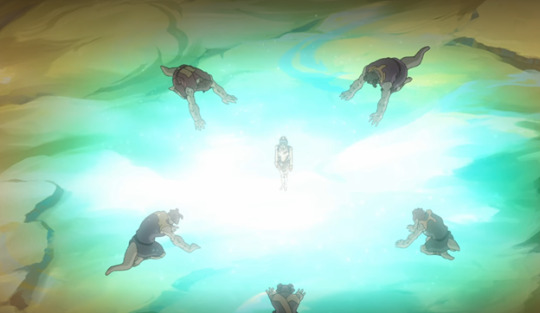
(Photo ID: A magic circle in the form of a pentagram, with a candle in the middle, compared to a screenshot of 5 Balmerans surrounding Allura in the form of a pentacle, creating a sacred space with Allura glowing in the center.)
The five points in particular mimic standard pentacle-based ritual circles designed to create a sacred space of some kind. We do see various configurations of witchcraft imagery used in other instances throughout the show, such as when the druids have to help Haggar sustain her spells:
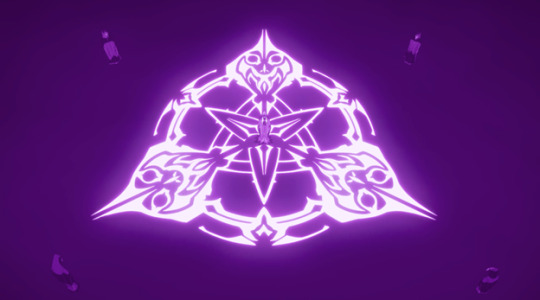
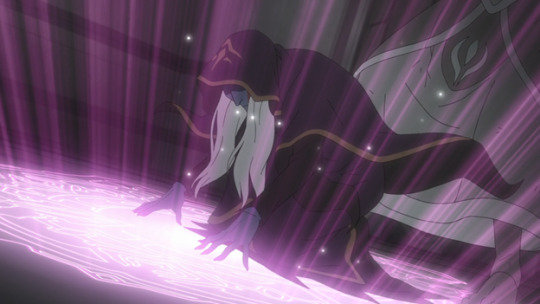
(Photo ID: Haggar centered in a magic circle, surrounded by druids helping her complete the ritual. Haggar kneels against the glowing symbols to complete the ritual.)
I think, similar to the druids that Haggar relied upon to help her complete a spell, it can be argued that the Balmerans were an active part of the regeneration spell with Allura. We see across the entire Balmera that they magically connect to help sustain the energy transfer, because it’s a planet-wide, massive undertaking:


(Photo ID: Balmerans activating their connection to the Balmera in the middle of the sacred ceremony to regenerate the Balmera.)
To me, it felt like the Balmerans were necessary to complete this ceremony--without their agreement to this energy exchange, and without them connecting to the Balmera to assist the transfer, Allura might not have been able to connect her life force and transfer power to the whole planet.
And to complete the ceremony, Allura herself kneels as well, just as Haggar did and just as the Balmerans around her do, in connection with the Balmera:
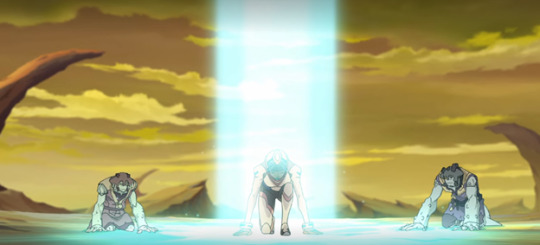
(Photo ID: Allura kneeling alongside Balmerans to complete the ritual.)
(Which means she’s technically kneeling to at least three other Balmerans in front of her.)
So I think the kneeling imagery would not correlate to some white savior complex event as suggested.
One other thought I had is that I feel help from a “white savior” is often haphazard and pushed onto recipients regardless of their thoughts or real needs. In comparison, we know that the Balmerans were willing to try this spell with Allura and accepted her idea of attempting the ancient ceremony. The only person who expressed hesitancy is Coran, who warns Allura that this attempt could kill her.

(Photo ID: Coran warns Allura, “To heal an entire planet, it could take more energy than you possess.”)
I do think it could again be argued that Allura seriously undermines her own value and worth in an attempt to help everyone, no matter the cost, which potentially gets more into white knight syndrome born out of trauma than white savior complex born out of privilege. She snaps back at Coran for being concerned about her well-being, and then she proceeds to enact the ceremony, not knowing for sure whether she’d live or die. But Allura also knows that her life force is uniquely tied to Voltron and that she is the only one with this kind of connection to the Castle ship’s battle-class Balmera crystal—all of this makes her a very powerful capacitor in a lot of ways. Which is why she looks like this after the ceremony:
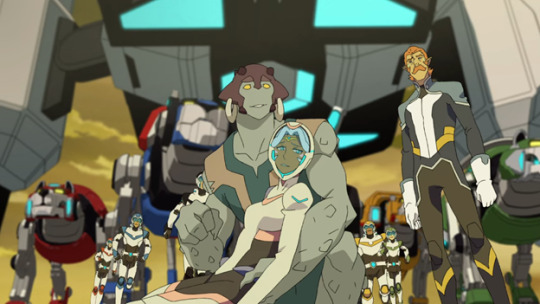
(Photo ID: Allura having collapsed in Shay’s arms after regenerating the Balmera, but her physical features are not otherwise affected.)
And not like this:
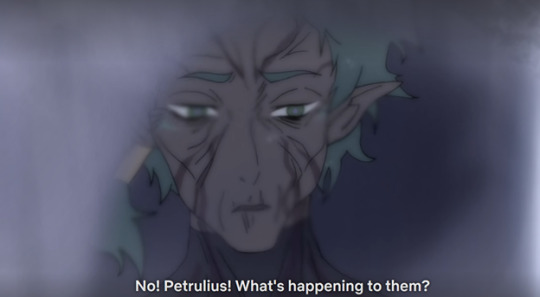
(Photo ID: A screenshot of an Altean named Petrulius from season 6, whose features are distorted after having had the life/quintessence sucked out of him.)
So to me, it seemed that Allura was enacting an ages-old, magical ceremony approved by and wanted by the Balmerans—simply on a scale that no one had ever before attempted. And it’s likely that no one else would or could attempt it, because Allura is the single character in the entire universe whose personal life force is tied to Voltron’s regenerative energy (by virtue of Alfor’s alchemy on her as mentioned in episode 1). It’s an even deeper tie to the whole machine than the transient bond between paladin and lion. No other Balmeran or Galran or Altean had that kind of tie in their life force. Likely, even Alfor would have died if he’d attempted this act himself without being connected to an infinite power source.
And after Allura saves the Balmera with assistance from Balmerans, we also do not see her like this with the Balmeran people:

(Photo ID: Lance soaking up a savior fantasy as previously mentioned in this meta.)
Instead, post-Balmera resurrection, we see it’s actually not even the Balmerans themselves who thank Allura. The Balmerans simply convey the will of the Balmera, which Allura cannot hear:

(Photo ID: A Balmeran says to Allura, “Yes. The Balmera lives. It thanks you.”)
So backing up for a second, I do think there are much larger issues happening in the narrative with Voltron itself, with the unequal power dynamics of having young, inexperienced people from a single planet make and enact all the big universal decisions. But in the instance with the Balmera, it seemed like Allura was openly welcomed to help save the planet, using magical ceremonies as approved by the Balmerans themselves for millennia, and that the Balmerans were not passive in those ceremonies but a necessary part of their success.
In general, Allura doesn’t seem to embody the “white savior complex” vibe at all to me, unlike some others in the show. Even in season 8, when Allura planned to make The Really Big Sacrifice, she asked her team to keep her actions a secret. She literally didn’t care for any respect or acknowledgment or prestige in exchange for sacrificing her life. She was doing what needed to be done because she was, once again, one of the few who could even perform at that level:
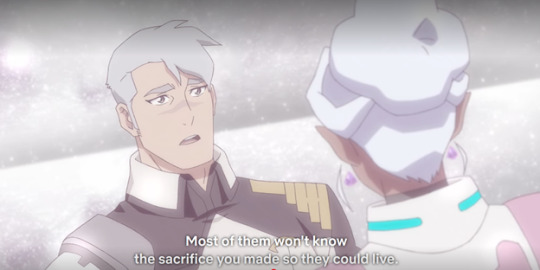
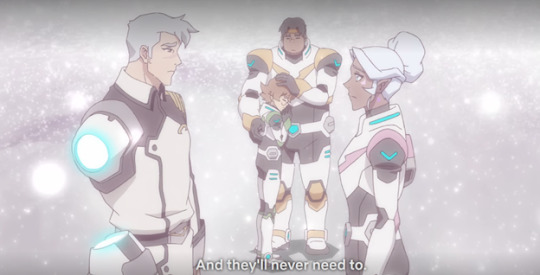
(Photo ID: Shiro says to Allura, “Most of them won’t know the sacrifice you made so they could live.” Allura replies, “And they’ll never need to.”)
(As an aside, I would argue that it was entirely unnecessary that the narrative would demand Allura sacrifice herself at all when she was literally standing in the universe’s seat of power alongside other powerful beings like her own father or the billions of other magic-wielding dead people, because apparently the lines between life and death blur in that space.)
(I also think there are some questionable “master race” vibes in the VLD universe in general, given that it forcefully pushes, even against the wishes of Alteans themselves, that Alteans are the only ones who can wield the big power to do big things. It’s clear that other groups and beings can wield magical abilities, but the larger narrative very oddly pins the “purest quintessence/bluest blood” back on Alteans time and time again in later seasons, leaving Allura in basically a no-win, no-help-available situation until other Alteans come along.)
So yeah, I hope something in this meta might help settle some concerns about Allura as a representation of white savior complex? Or at least that this would open conversation for further discussion about what could be done in future iterations to avoid that messaging. Because yeah, I agree with you that the unquestioned savior complexes in this show are a topic that can and should be discussed! And also that, despite early world-building to suggest otherwise, the narrative especially in s6-s8 pushes that Alteans have a “purer/more alive” life force compared to any other race or form. Which is just…hm. Like, the master race vibes of all that are weird and definitely not even inherent to the Voltron franchise. (In previous iterations, humans, Galrans/Drule, and Alteans could all perform incredible levels of magic. For example, in Dynamite Voltron, Keith, Lotor, and Lotor’s siblings had all been taught magic.)
There’s definitely some weird images and unnatural power dynamics in VLD at times. It seems like more often than not, the narrative does strive to make Allura sacrificing something the only viable resort for anyone ever. In those circumstances, I’m just not convinced that she herself functions as an embodiment of white savior complex, by virtue of her behavior in those instances. But it’s definitely weird that the narrative places so much weight on her when the larger Team Voltron narrative is supposed to be about found family and strength in unity.
(If you read this far, thank you! Sorry I’m not succinct.)
#Voltron#Voltron meta#Voltron critical in ways#Allura#Balmera episode#discussions of white savior complex#I ultimately state that Allura doesn't seem to meet the basic behaviors for that#but the show does get into some strange master race stuff in terms of abilities#and we do see several iimages of white savior complex throughout the show by virtue of some other characters#which idk why that got dropped in without at least a reflection on it#like I can handle problematic stories but prefer it when they know they're problematic lol#in VLD it felt like I was supposed to be cheering for those issues#that I wasn't supposed to question it or that I was supposed to actually connect with that fantasy#I feel like this is a really interesting topic because in other iterations there were other Voltrons#as in more people had similar machines#which I feel like helped to control the savior complex inherent in manning a powerful weapon#and in fact one iteration goes as far to say that voltron ISN'T special at all#which surprises various characters#Just a very different vibe from VLD entirely#I'm really fascinated by that#Anyway thanks for reading my rambles!
30 notes
·
View notes